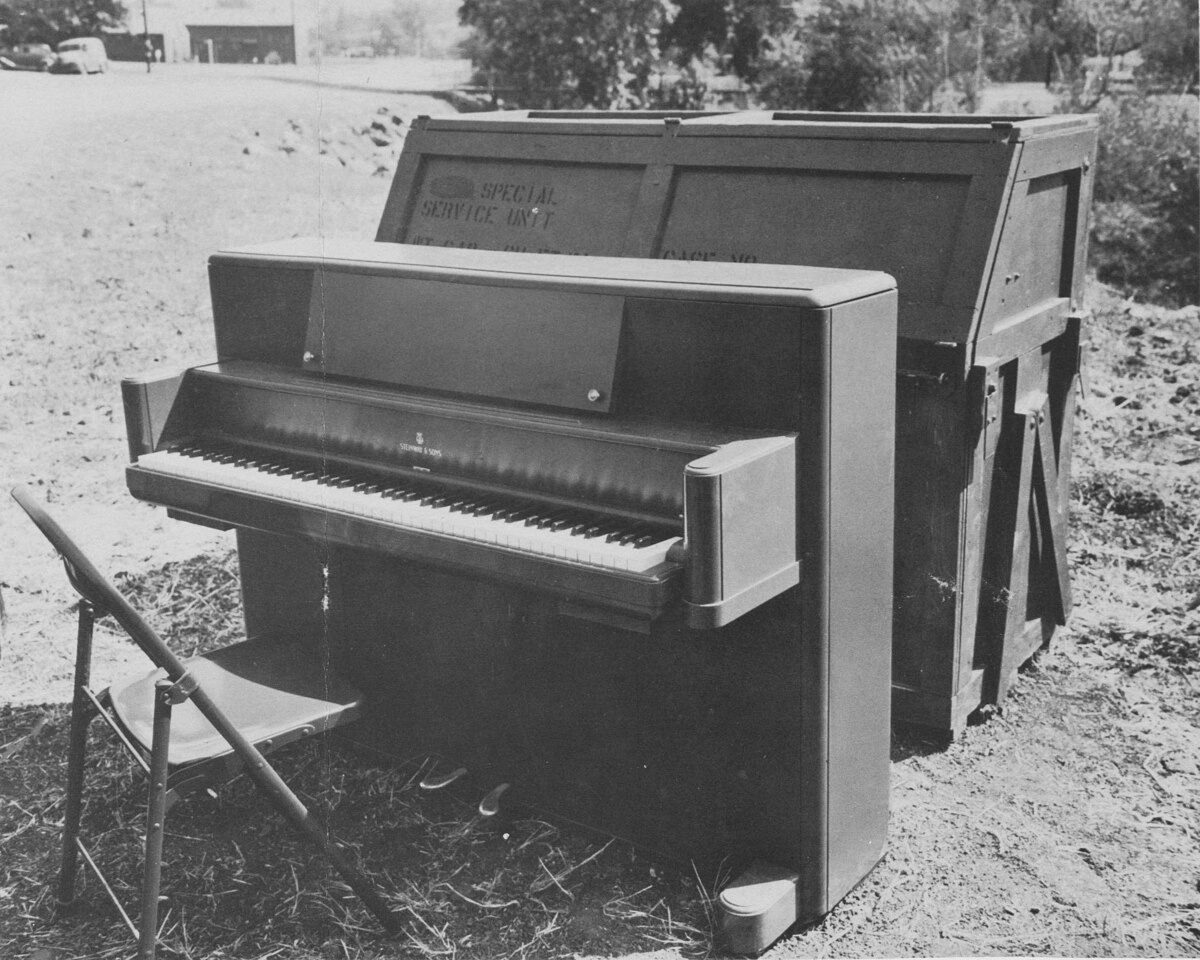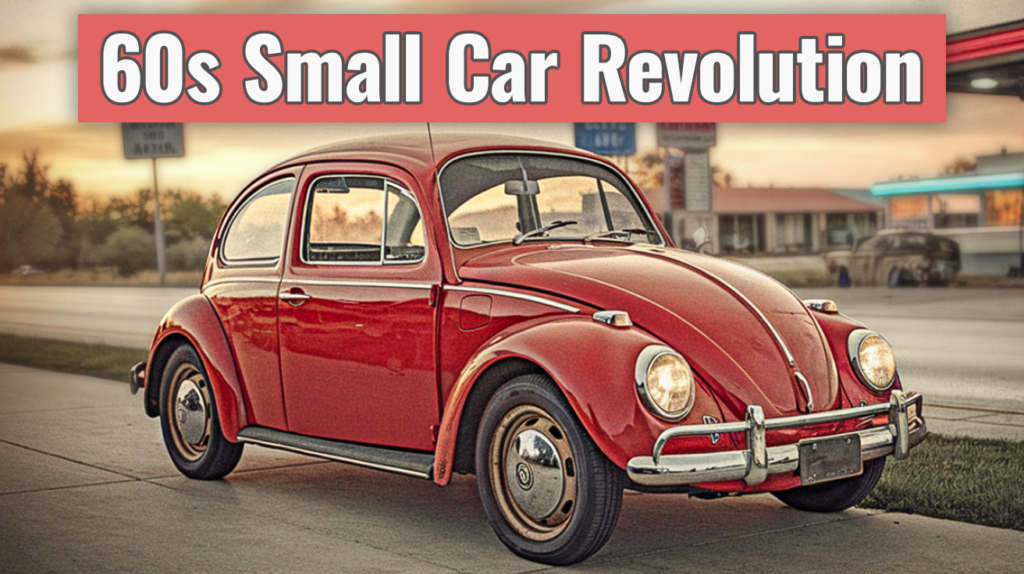
Ever wondered why compact cars from the 1960s still capture our imagination? These automotive underdogs packed remarkable innovation into tiny packages, often solving problems that modern SUVs ignore. Their clever designs maximized interior space while minimizing parking footprints. Engineers focused on functionality over flash, creating vehicles that remained practical for decades.
The golden age of compacts teaches us valuable lessons about thoughtful design that today’s market desperately needs.
45. Chevrolet Corvair (1960) (Exterior)
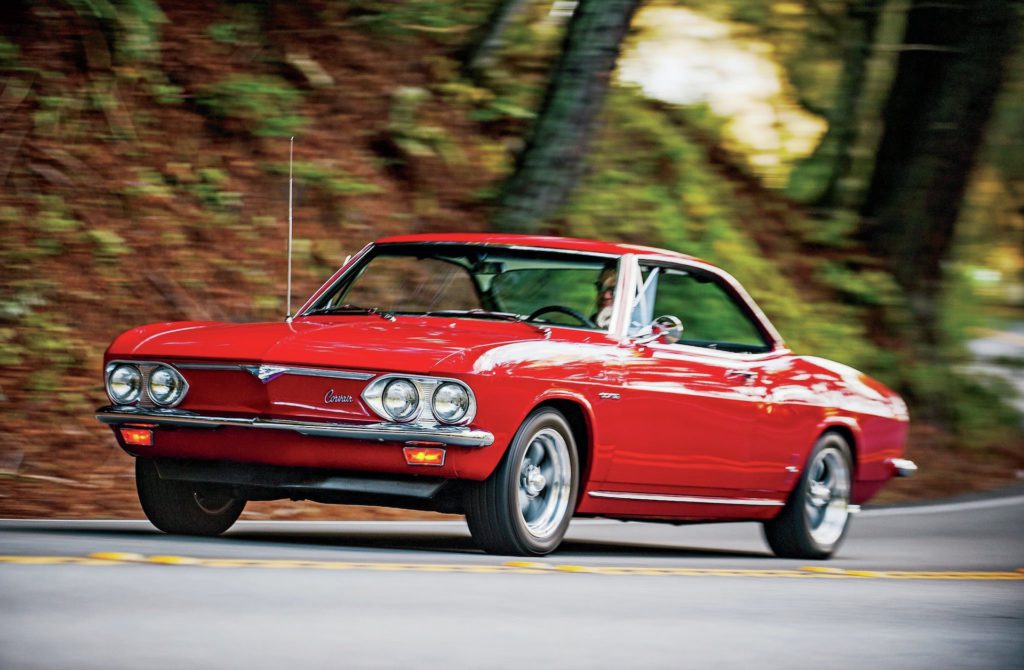
Chevrolet broke every Detroit rule with the 1960 Corvair’s European-inspired package and rear-engine layout. Built on a 108-inch wheelbase and measuring a tidy 180 inches in length, this revolutionary compact boldly abandoned tailfins and chrome excesses when such features still dominated showrooms. You’d immediately notice the shorter hood—a dead giveaway to the absent front engine—creating proportions unlike anything else wearing an American badge. Curved side glass and flush headlights enhanced the contemporary look while unibody construction kept weight to a manageable 2,400 pounds. When you parked your Corvair next to conventional American sedans, the contrast couldn’t be more striking—here was physical proof that Detroit could create forward-thinking designs when properly motivated by European competition.
Chevrolet Corvair (1960) (Interior)
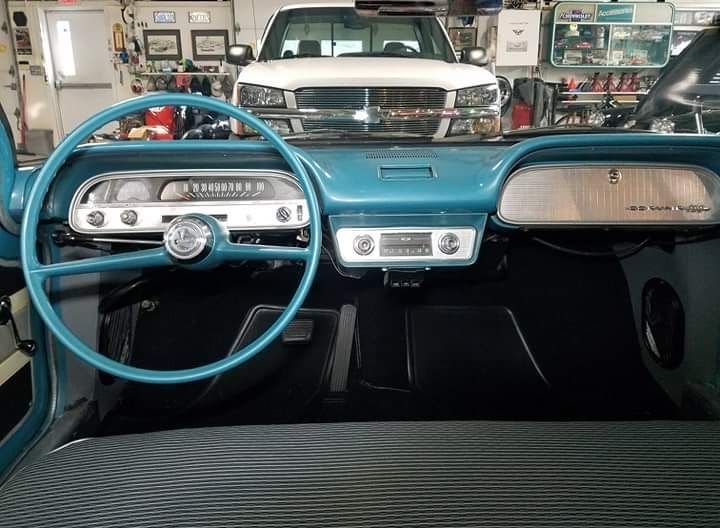
Slip behind the wheel of a Corvair and you’d immediately appreciate its most distinctive feature—a completely flat floor unmarred by the transmission tunnel that invaded passenger space in every other American car. The dashboard featured aircraft-inspired gauges positioned to be read at a glance during spirited driving along winding roads. Monza models pampered you with bucket seats that hugged your sides during cornering, a sporty touch when most domestic cars still used bench seats. Fresh air ventilation pulled from the front, cleverly minimizing engine heat infiltration that often plagued rear-engine designs. While Ralph Nader would later criticize its handling characteristics, the Corvair’s thoughtful interior revealed GM’s capacity for innovation when freed from design traditions—a lesson the company would repeatedly forget and relearn throughout the following decades.
44. Ford Falcon (1960) (Exterior)
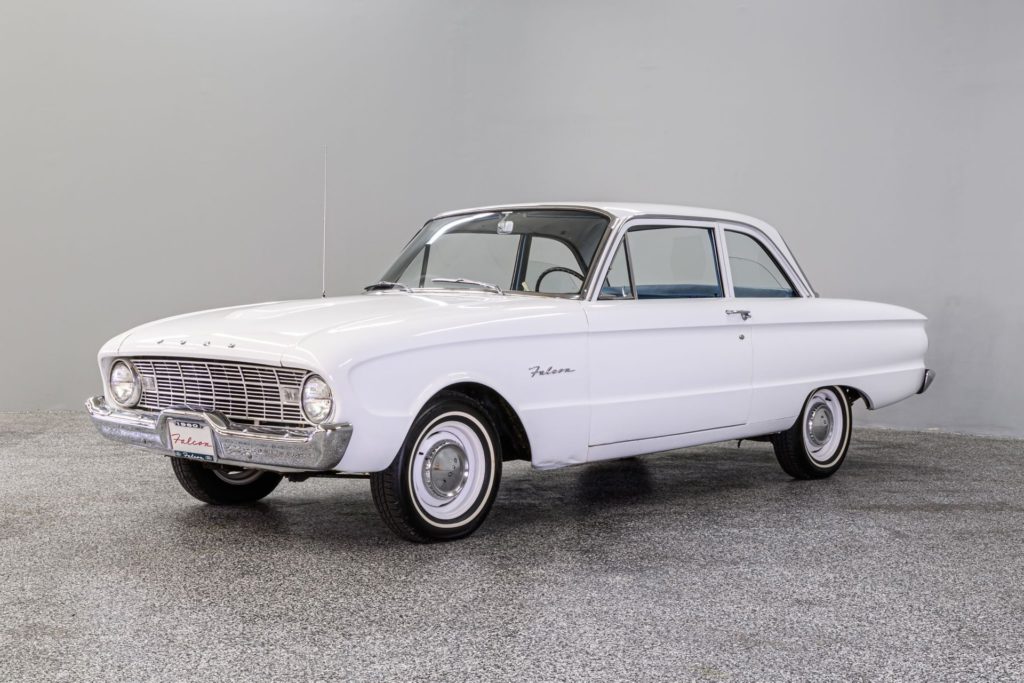
Ford’s 1960 Falcon delivered exactly what practical Americans wanted—sensible dimensions in a conventional, approachable package. The 109.5-inch wheelbase and 181-inch length struck the perfect balance between maneuverable and roomy, while the featherlight 2,300-pound construction paid dividends at the gas pump. You’d appreciate the superb visibility through those large greenhouse areas with pencil-thin pillars—no need for today’s electronic parking aids when you could actually see where you were going. The crisp, uncluttered body avoided styling gimmicks, with just enough horizontal grille work and modest chrome trim to look appropriate in suburban driveways. While competitors chased trends, the Falcon’s straightforward honesty struck a chord with value-conscious buyers, creating the template that would eventually birth the Mustang and reshape American car culture for decades to come.
Ford Falcon (1960) (Interior)
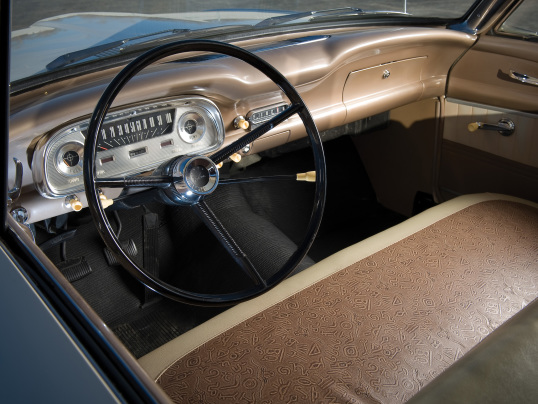
Settle into a Falcon and you’d find a cabin that prioritized clarity and function without unnecessary flourishes. The clean dashboard presented controls exactly where you expected them, while the three-spoke steering wheel provided a clear view of straightforward gauges. Front and rear benches made family trips comfortable enough, though you wouldn’t mistake them for living room furniture. Durable vinyl upholstery in various colors shrugged off the abuse of daily life and active children without complaint. The airy greenhouse eliminated the closed-in feeling that made many compacts feel like penalty boxes despite their reasonable external dimensions. While Detroit marketing departments pushed planned obsolescence and annual style changes, the Falcon’s unpretentious interior represented a refreshing honesty that helped make it Ford’s most successful compact launch—a lesson in giving customers substance over sizzle that continues to separate successful car designs from forgotten ones.
43. Plymouth Valiant (1960) (Exterior)
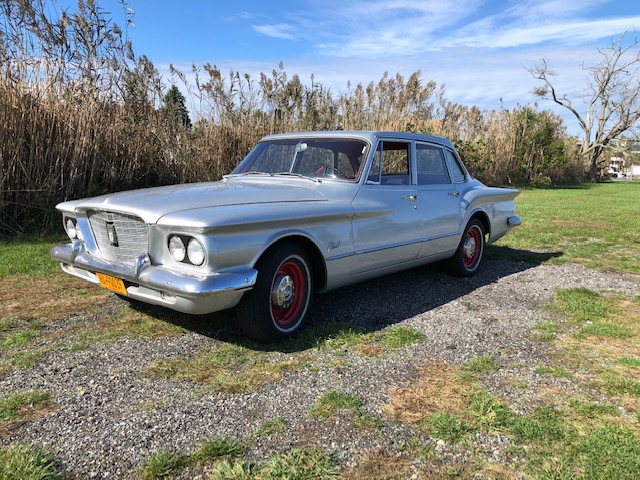
Plymouth’s distinctive 1960 Valiant brought personality to the compact segment on its 106.5-inch wheelbase and 184-inch length. Unlike the conservative offerings from Ford and Chevrolet, the Valiant dared to be different with asymmetrical hood stamping and concave grille work that demanded second glances. Bold rear fender lines swept dramatically from doors to trunk, creating what Chrysler marketers called “stabilizer fins”—a fancy term for a genuinely unique profile. The front fenders stretched beyond headlights into cat’s-eye housings you couldn’t mistake for anything else on the road. Weighing in at 2,500 pounds, the unibody structure provided rigidity without excess mass. When you parked your Valiant at the local drive-in, its unconventional styling made a statement that mainstream compacts couldn’t match—proof that practical transportation needn’t be visually forgettable.
Plymouth Valiant (1960) (Interior)
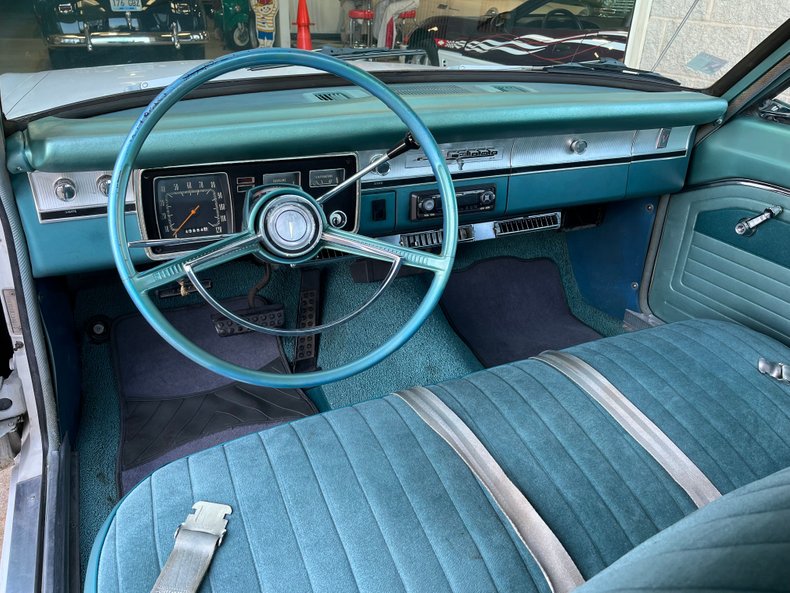
The Valiant’s cabin successfully balanced daily practicality with touches of Chrysler’s distinctive design flair. Most conversations about the interior inevitably started with the push-button automatic transmission selector—a conversation piece that delighted passengers unfamiliar with this Chrysler hallmark. Essential gauges clustered in a driver-facing pod communicated vital information without distraction, while bench seats offered reasonable space in both front and rear rows. Vinyl upholstery in various colors reflected the more adventurous palette choices of the early 1960s without requiring special care. The generous greenhouse eliminated blind spots that would concern today’s drivers accustomed to backup cameras and sensors. While competitors played it safe with conventional designs, the Valiant’s distinctive character found enough buyers to prove that Americans could appreciate quirky design when paired with solid engineering—a formula that still distinguishes memorable cars from automotive wallpaper.
42. Dodge Dart (1963) (Exterior)
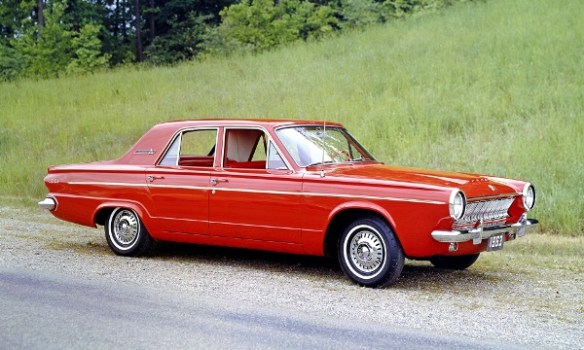
The 1963 Dodge Dart emerged with crisp styling that balanced distinction with broader appeal on its 111-inch wheelbase and 196-inch length. Moving away from the polarizing design of earlier Dodge compacts, the Dart found the sweet spot between conventional and characterful. Sharp body creases created definition along the flanks, connecting front to rear with purposeful lines that caught sunlight dramatically. Quad headlights flanked a concave grille with just enough interest to stand out in parking lots without becoming dated. At approximately 2,700 pounds, the unibody structure delivered rigidity without unnecessary heft. When you pulled up beside full-size models of the era, the Dart looked perfectly proportioned rather than compromised—a right-sized approach that attracted buyers who wanted something substantial without the excess dimensions and thirst of typical American sedans.
Dodge Dart (1963) (Interior)
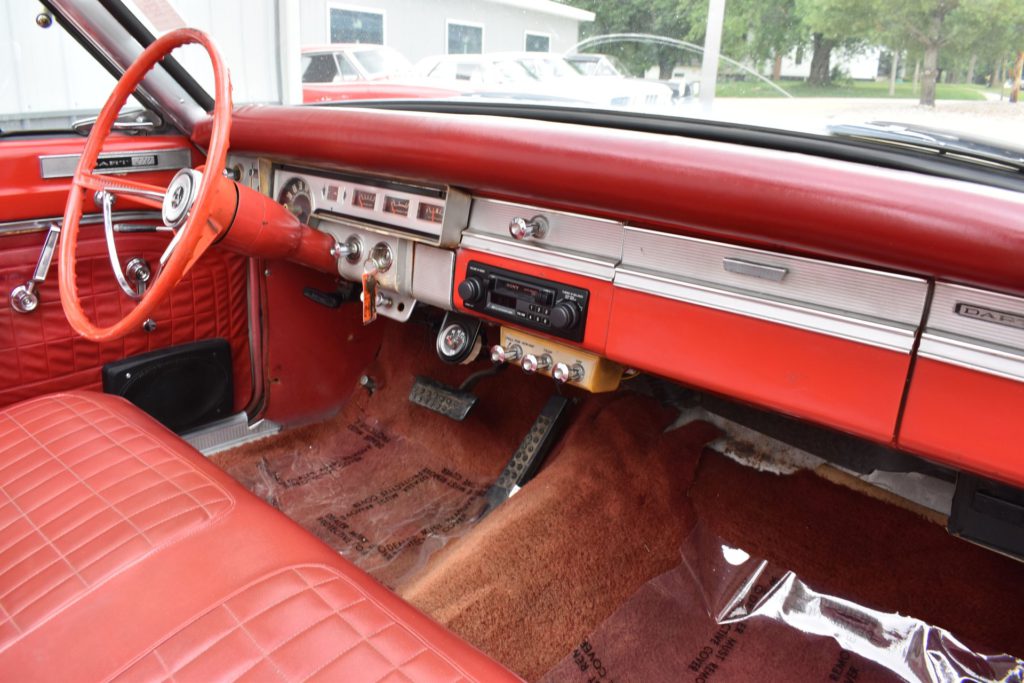
Step inside a Dart and you’d discover why Chrysler’s compacts developed such a loyal following. The thoughtfully designed instrument panel positioned gauges in a concave housing directly ahead for perfect visibility without requiring you to take your eyes far from the road. Contrasting upholstery options in vinyl or cloth added visual warmth in an era when many economy car interiors resembled penalty boxes. Rear passengers particularly appreciated the generous legroom that smaller compacts simply couldn’t provide, making the Dart a legitimate family car rather than just commuter transportation. The sizeable glove compartment and door pockets swallowed road trip essentials without overflowing into the cabin. While competitors often betrayed their budget roots with cheaper materials and assembly shortcuts, the Dart’s superior craftsmanship reflected Dodge’s slightly upmarket position—one reason these practical compacts developed such passionate owners who kept them running decades longer than their planned obsolescence should have allowed.
41. Mercury Comet (1960) (Exterior)
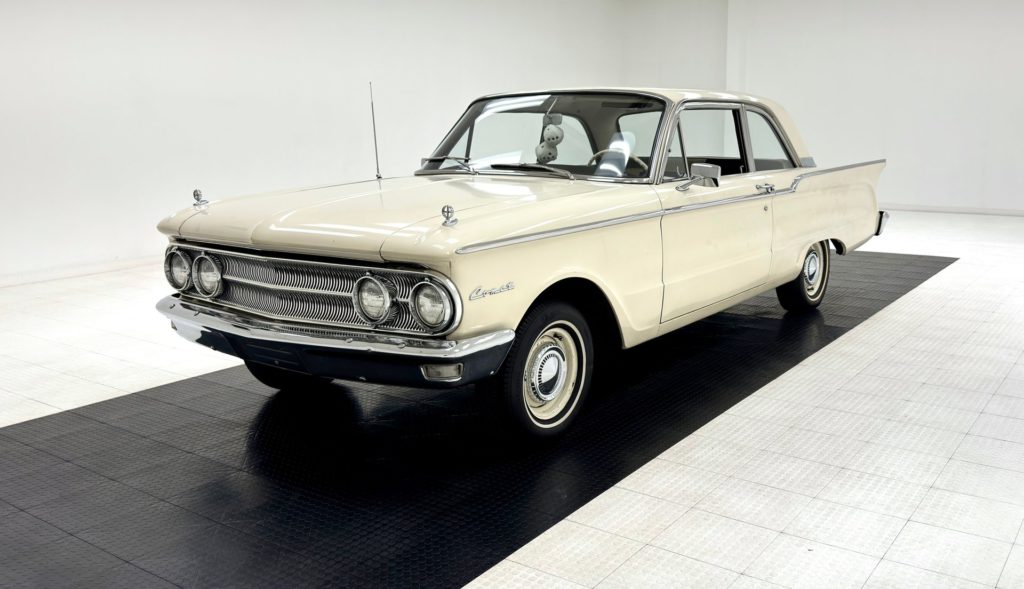
Mercury stretched the Falcon’s bones to create the more upscale Comet with its longer 114-inch wheelbase and 194-inch length, balancing compact efficiency with near-midsize presence. The styling incorporated subtle luxury touches like fine-mesh grille work and more elaborate side trim that distinguished it from its Ford cousin without appearing pretentious. Dual headlights nestled in chrome bezels flanked a horizontal grille with Mercury’s signature “floating M” emblem—just enough flash to justify its premium positioning. Those distinctive wrapped taillights provided a classy nighttime signature unlike the Falcon’s simpler units. When you parked your Comet at the country club, it didn’t scream “economy car” like other compacts—it whispered “sensible luxury” to a growing demographic of buyers who wanted prestige without the fuel bills and parking challenges of full-size luxury models.
Mercury Comet (1960) (Interior)
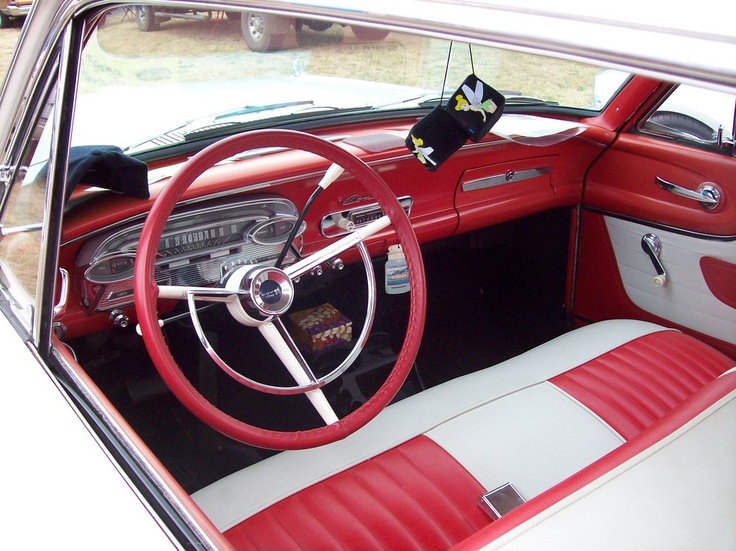
Slide behind the Comet’s wheel and you’d immediately notice the upmarket appointments that justified its premium over the Falcon. The dashboard featured an oval-shaped instrument cluster housing the speedometer and auxiliary gauges—a distinctive touch that made every drive feel more special than the price difference might suggest. Upholstery utilized higher-grade vinyl or optional cloth with more intricate patterns that resisted showing wear on long trips. The extended wheelbase directly benefited rear passengers with legroom that made compact car claustrophobia a thing of the past. Front and rear bench seats accommodated six when needed, though bucket seats in sportier models hinted at the personal luxury direction Mercury would increasingly explore. While Detroit continued pushing ever-larger models on consumers, the Comet proved that right-sized luxury had a place in American driveways—a formula that would eventually evolve into the highly successful “personal luxury” segment that dominated the 1970s.
40. Studebaker Lark (1962-1963) (Exterior)

The 1962-1963 Lark brought sophistication to the struggling Studebaker lineup with clean European-inspired lines on its 113-inch wheelbase and 188-inch length. This thoughtful redesign eliminated the fussy details of earlier models in favor of crisp edges and balanced proportions that aged remarkably well. The front featured Mercedes-influenced styling with a simple horizontal grille and uncluttered headlight arrangement that looked expensive beyond its price point. At approximately 2,800 pounds, the Lark maintained a weight advantage over most domestic competitors while preserving structural integrity. Thin pillars supporting the roof created excellent visibility that today’s thick-pillared safety designs can’t match. When you parked your Lark next to the overstyled domestic competitors of the era, its clean design looked almost prophetic—a glimpse of the design direction that wouldn’t become mainstream for another decade, by which time Studebaker had sadly departed the automotive scene.
Studebaker Lark (Interior)
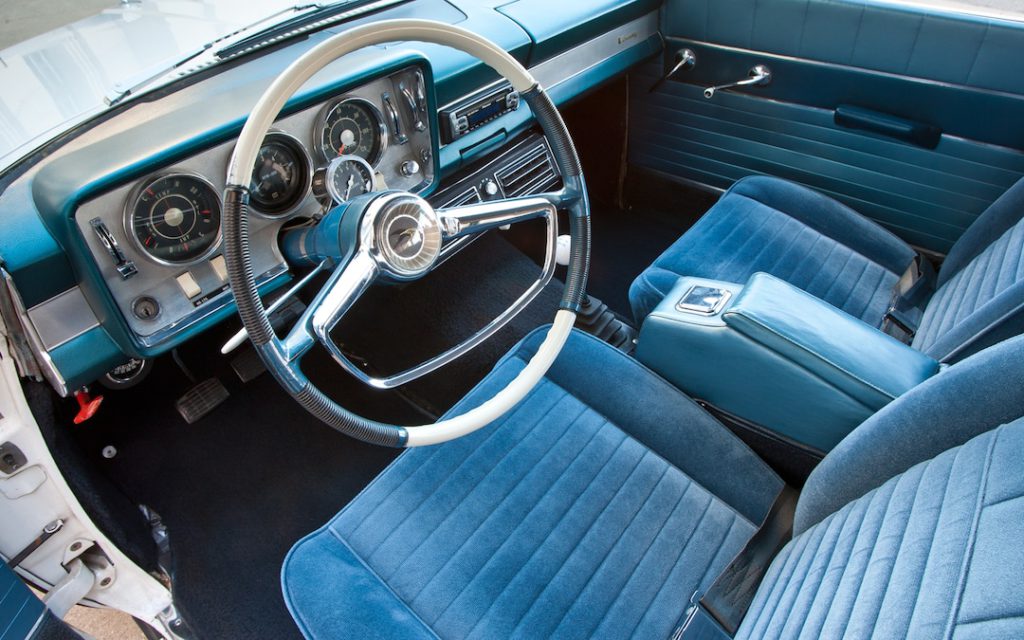
The Lark’s cabin delivered unexpectedly refined accommodations that belied its modest price position. The dashboard presented cleanly organized gauges with logical placement and functional simplicity that made driving intuitive. Upscale vinyl and cloth options provided comfort and durability exceeding typical compact standards, making long trips less of a compromise than in many economy alternatives. The standard front bench could be swapped for sportier bucket seats in premium models, offering a level of choice unusual in the compact segment. The three-spoke steering wheel with full horn ring felt substantial in your hands, suggesting quality that extended throughout the cabin. When you showed friends your new Lark, they’d be surprised by how spacious and well-appointed it felt compared to its exterior footprint—a testament to Studebaker’s ability to deliver premium feel despite the company’s financial challenges that would eventually force its merger with Packard and ultimate withdrawal from the American market.
39. Pontiac Tempest (1961) (Exterior)
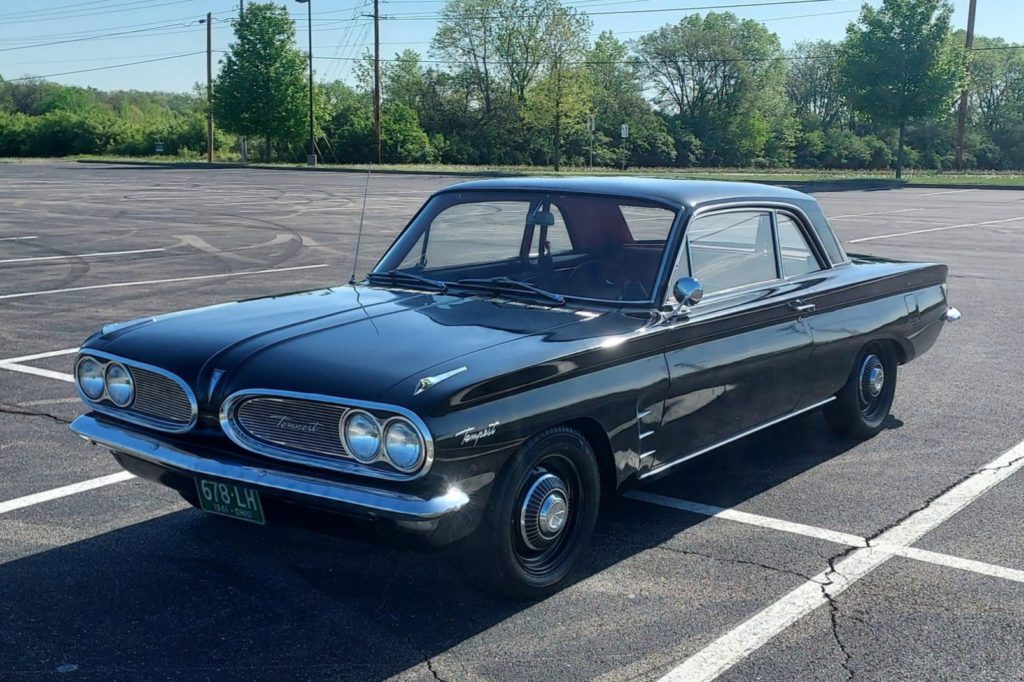
Pontiac’s innovative Tempest stretched across a 112-inch wheelbase and 188-inch length, merging compact dimensions with styling cues from the division’s larger models. Clean body sides featured subtle character lines complemented by the brand’s signature split grille up front—unmistakably Pontiac despite its smaller footprint. Distinctive rear fender shapes with tasteful tailfins housed vertical taillights, creating visual connections to full-size models that boosted the compact’s prestige. At 2,600 pounds, the unibody structure delivered rigidity without unnecessary mass. Large windows set in thin pillars eliminated blind spots that plague modern designs with their thick safety structures. When you pulled into a drive-in restaurant alongside other GM compacts, your Tempest stood out with its more sophisticated proportions and sporting character—a perfect reflection of Pontiac’s emerging performance image that would soon revolutionize American car culture with the GTO.
Pontiac Tempest (1961) (Interior)

The Tempest interior brilliantly translated Pontiac’s sporting character to a smaller package without feeling compromised. A distinctive round-gauge instrument cluster positioned directly before the driver provided clear information with a touch of sports car flair. Seating options included front benches for those seeking maximum capacity or buckets for drivers who appreciated lateral support on winding roads. Most remarkable was the completely flat front floor—a direct benefit of the innovative rear transaxle design that eliminated the driveshaft tunnel intrusion found in every other front-engine American car. When you took friends for their first Tempest ride, you’d inevitably point out this unique feature that created surprising roominess in what looked like a conventional layout. While most compacts felt like obvious compromises compared to their full-sized stablemates, the Tempest delivered an experience that sometimes improved on larger models—evidence of GM’s engineering prowess when properly motivated by the compact car challenge.
38. Oldsmobile F-85 (1961) (Exterior)
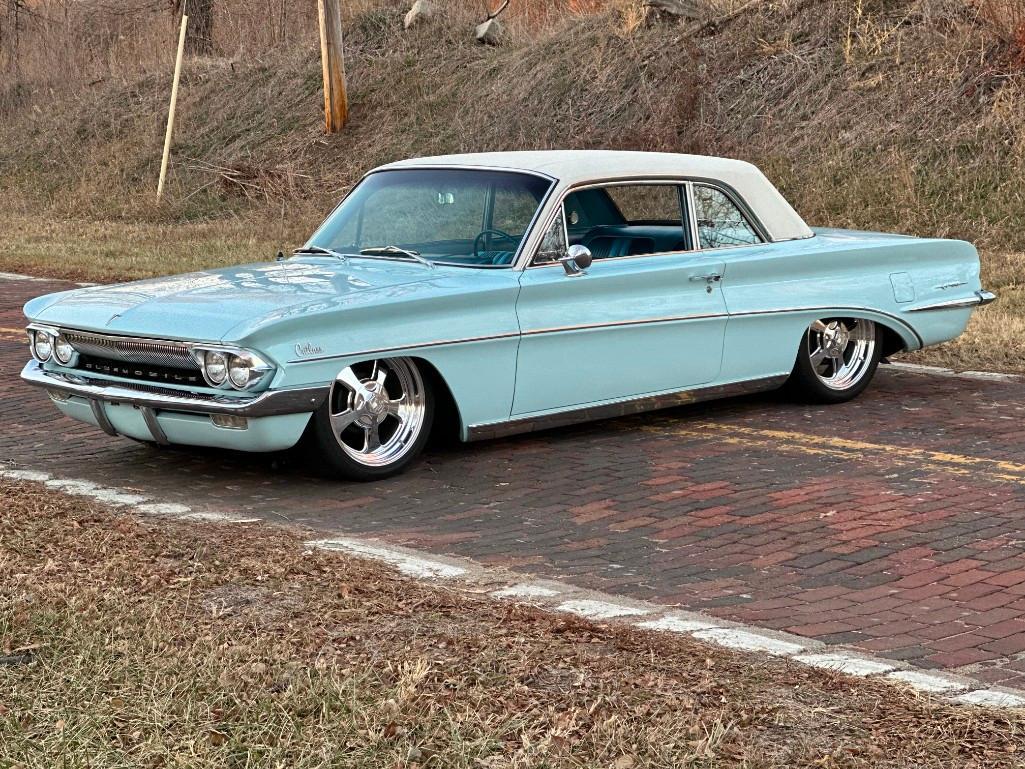
Oldsmobile’s sophisticated 1961 F-85 brought premium touches to the compact segment with its 112-inch wheelbase and 188-inch length. The design incorporated distinctive concave bodysides creating visual interest without excessive brightwork—a restrained approach when chrome still dominated American styling. The front featured Oldsmobile’s trademark split grille flanked by dual headlights in tasteful chrome housings. Rear styling utilized horizontal taillights integrated into modest tailfins that maintained visual connection to larger Oldsmobiles without appearing excessive. At approximately 2,600 pounds, the unibody structure balanced mass with necessary rigidity. When you parked your F-85 in the driveway, neighbors could tell it wasn’t just another basic compact—it carried the presence of a more premium vehicle despite its efficient dimensions, reinforcing Oldsmobile’s position as a step up from mainstream brands while foreshadowing the compact luxury segment that would eventually become crucially important to American manufacturers.
Oldsmobile F-85 (1961) (Interior)
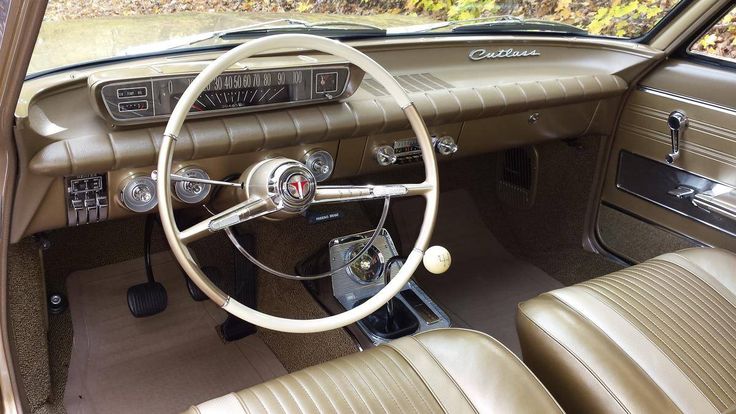
Step inside the F-85 and you’d discover near-midsize comfort with premium materials that justified its higher price point. The dashboard featured a horizontal speedometer with clear markings and logical control placement that made everything fall naturally to hand. Seating options included bench or bucket configurations with quality vinyl upholstery in various color schemes that coordinated with exterior paint options. Front dimensions provided generous head and legroom, while rear accommodations offered adequate space for adults on all but the longest journeys. The dashboard and door panel padding added luxury touches typically absent in compact competitors, creating a more substantial feel. When you showed off your new F-85 to friends, they’d be impressed by how convincingly it translated Oldsmobile’s premium character to a smaller package—proof that downsizing didn’t have to mean downgrading, a lesson Detroit would repeatedly forget and painfully relearn in the decades that followed.
37. Buick Special (1961) (Exterior)
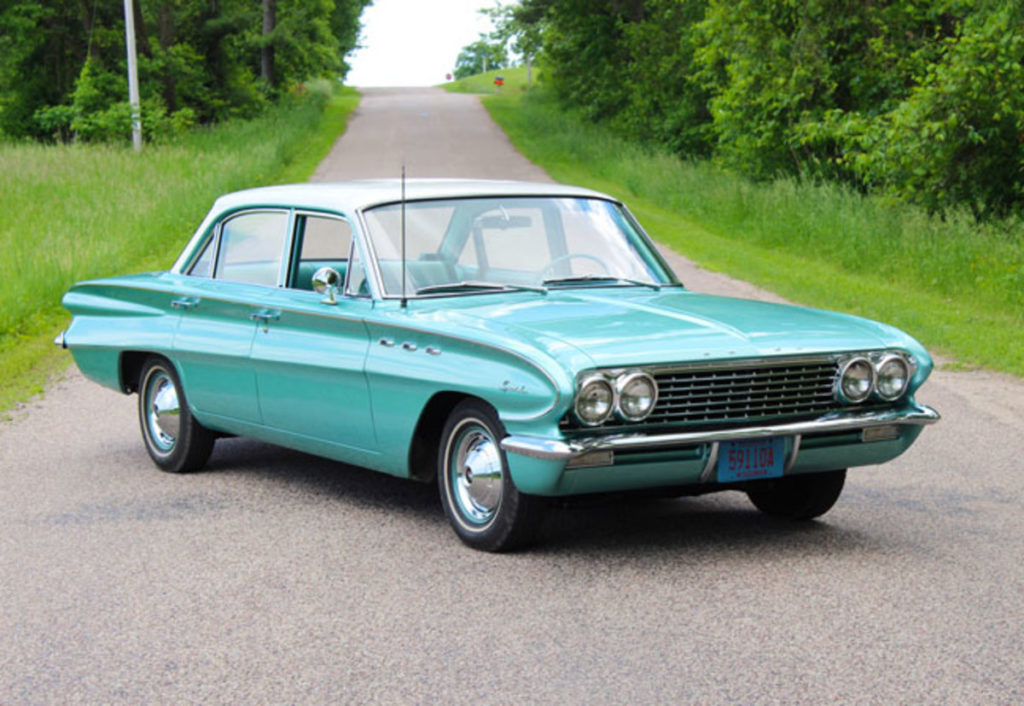
Buick successfully translated its upscale design language to compact dimensions with the 1961 Special’s 112-inch wheelbase and 188-inch length. Clean body sides featured subtle character lines complemented by distinctive “delta wing” rear fenders creating visual interest without resorting to excessive ornamentation. The front incorporated Buick’s characteristic horizontal-bar grille flanked by dual headlights in tasteful chrome surrounds. At roughly 2,700 pounds, the unibody construction maintained reasonable weight while ensuring structural integrity. The greenhouse utilized thin pillars and generous glass areas, creating visibility that drivers of today’s thick-pillared cars would envy. When your neighbors saw the Special in your driveway, they recognized it instantly as a Buick despite its more efficient dimensions—proof that brand identity could survive downsizing without losing character, a crucial lesson as American cars would eventually need to shrink in response to changing market conditions.
Buick Special (1961) (Interior)

The Special welcomed you with a cabin that delivered near-midsize comfort with premium touches expected from a Buick. The dashboard positioned a horizontal speedometer with easy-to-read markings and logical control placement that required no hunting for essential functions. Seating options included bench or bucket configurations with quality vinyl upholstery in tasteful colors and patterns that coordinated thoughtfully with exterior finishes. Front space provided generous accommodation for drivers of all sizes, with adequate rear seating for adults that didn’t feel like a penalty. Dashboard and door panel padding added luxury touches that separated the Special from lesser compacts, creating an upscale environment that justified its premium position. When you took friends for a drive in your new Special, they’d forget they were in a “compact”—a testament to Buick’s successful translation of its luxury identity to a smaller package at a time when most Americans still equated size with status.
36. Peel P50 (Exterior)
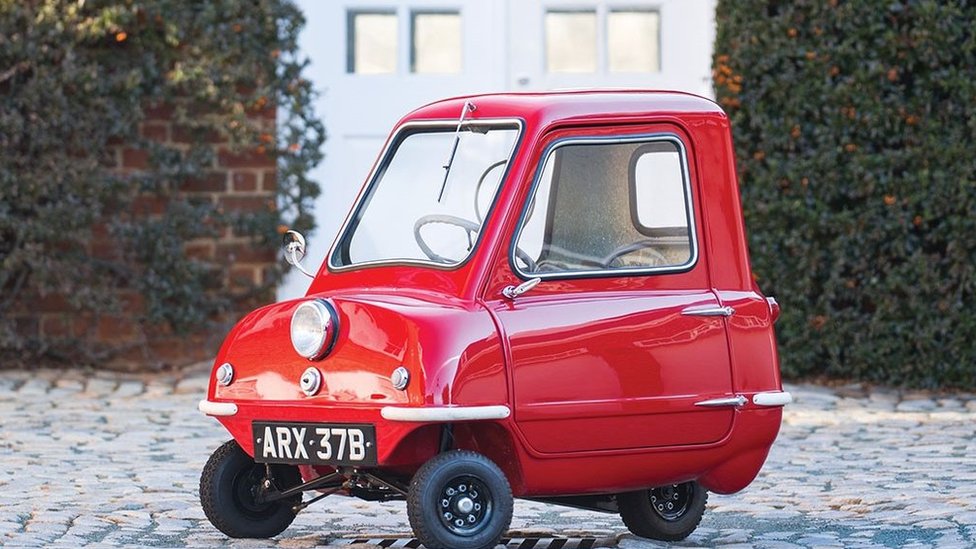
The Peel P50 earned fame as the world’s smallest production car with its minimal 50-inch wheelbase and 54-inch total length—dimensions that made motorcycles seem spacious by comparison. This microcar featured a single door on the left side and one headlight centered on its tiny nose. The fiberglass shell weighed a scant 130 pounds and came finished in bright colors that emphasized its toy-like proportions. With no reverse gear, you’d physically lift the rear to turn around—a party trick that never failed to amaze onlookers. The three-wheel layout—two in front, one in rear—provided basic stability while maintaining that incredibly narrow footprint. When you navigated a P50 through congested London streets, pedestrians would stop and stare in disbelief at what appeared to be a rolling phone booth with wheels—proving that automotive minimalism could create more attention than the grandest Rolls-Royce when taken to its logical extreme.
Peel P50 (Interior)
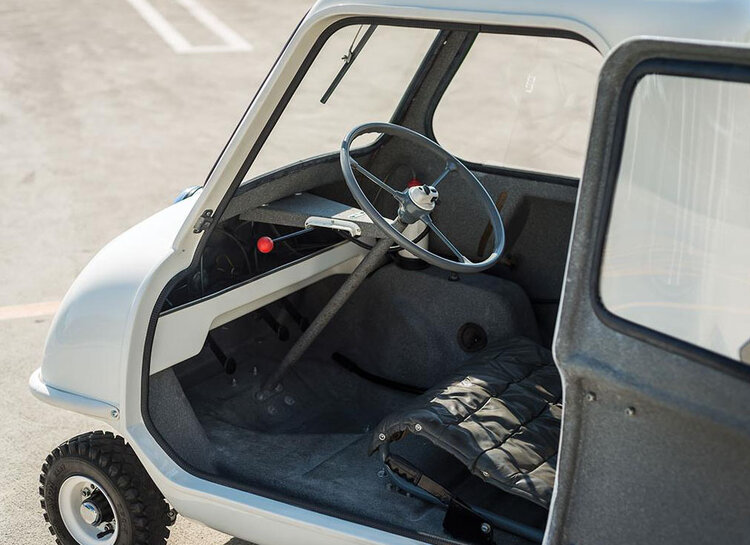
The P50’s “interior” stretched the definition to breaking point, providing just enough space for a single adult driver and nothing more. Your shoulders would nearly touch both side panels simultaneously, creating an intimate relationship with the vehicle unlike anything else on the road. Basic controls included only absolute necessities: steering wheel, throttle, brake, lights, and horn—no radio, no heater, not even a passenger seat to keep you company. The rudimentary dashboard typically featured just a speedometer, leaving you to guess about fuel level and engine temperature. Entry required a specific technique through the single door, folding yourself into a space that made economy airplane seats seem luxurious by comparison. While modern microcars provide at least basic amenities, the P50’s brutal minimalism represented transportation distilled to its absolute essence—a rolling argument that most vehicles contain far more than necessary for basic mobility, a point that remains relevant in today’s era of ever-larger personal vehicles.
35. Bond Minicar Mark G (1961-1966) (Exterior)
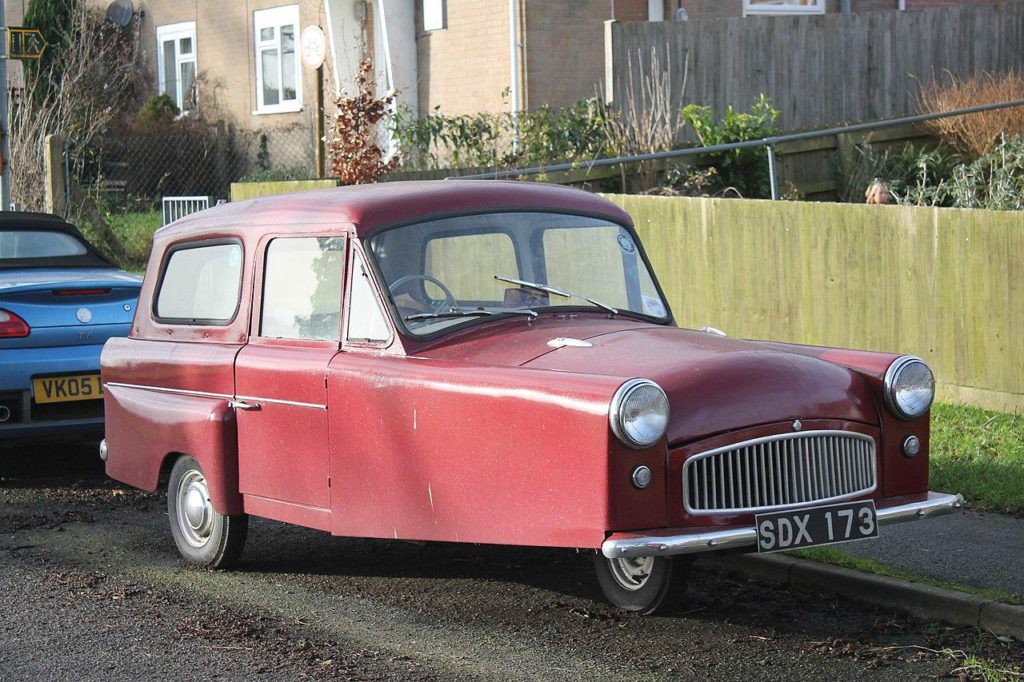
The Bond Minicar Mark G showcased evolutionary refinement on its 72-inch wheelbase and 122-inch length—dimensions that made parallel parking a trivial exercise. This three-wheeler placed its single wheel at the rear, creating a distinctive teardrop silhouette that turned heads throughout Britain. The fiberglass construction kept weight to just 605 pounds while providing basic weather protection lacking in motorcycles. Front-hinged doors replaced earlier side-hinged designs, improving both access and crash safety—though “safety” remained a relative term for these minimal vehicles. When you puttered through town in your Mark G, pedestrians would point and smile at its cheerful appearance and diminutive size—a reaction that owners enjoyed almost as much as the vehicle’s miserly fuel consumption and the tax advantages of its three-wheel classification that saved substantial money in Britain’s heavily-taxed automotive market.
Bond Minicar Mark G (1961-1966) (Interior)
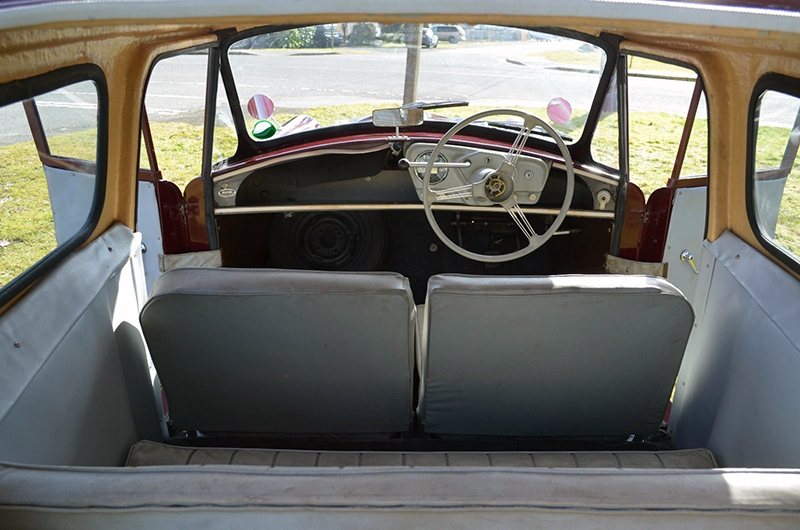
Inside, the Mark G provided bare-bones accommodations focused on basic transportation rather than comfort or luxury. The bench seat accommodated two adults in close proximity—an arrangement that worked better for couples than casual acquaintances given the shoulder-to-shoulder seating. Simple gauges provided essential information without distraction, typically limited to speed and fuel level to keep manufacturing costs low. Floor-mounted controls included a motorcycle-style gear change and basic switches that required minimal explanation. The steering wheel positioned directly before the driver created a reasonably comfortable operating position despite the car’s minimal dimensions. When rain pattered on the roof during British downpours, you’d feel smug watching motorcyclists getting soaked while you remained relatively dry—the Minicar’s primary selling point over two-wheeled alternatives, delivered at minimal cost while maintaining similar operational economy and tax advantages.
34. Reliant Regal Mark 7 (1962) (Exterior)
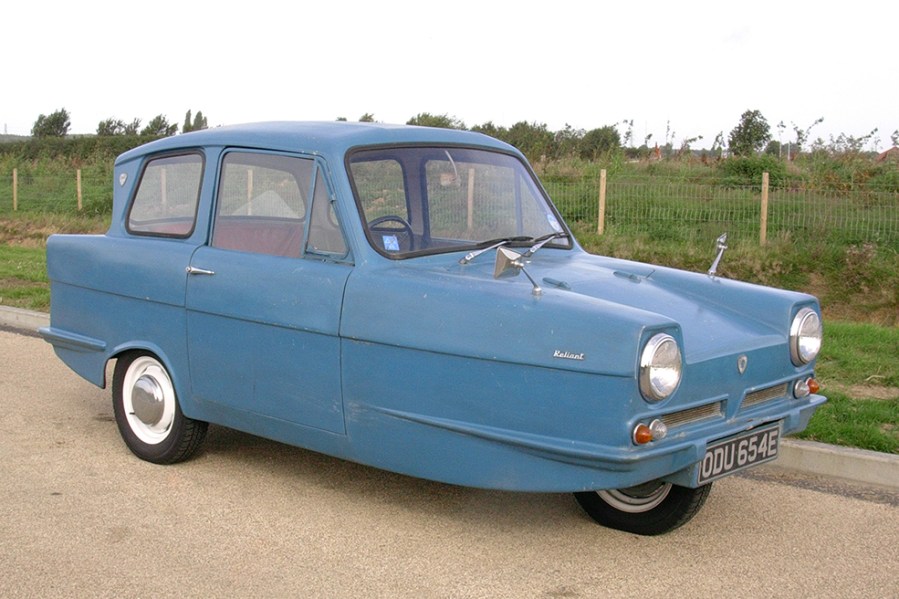
The 1962 Reliant Regal Mark 7 continued Britain’s peculiar three-wheel tradition with its fiberglass body weighing just 830 pounds. Built on an 84-inch wheelbase and stretching 135 inches long, the Regal positioned its single wheel up front for a reverse-trike configuration that created distinctive handling characteristics. The nose tapered dramatically to accommodate steering components, creating a teardrop profile unlike conventional cars. Large front windows and a generous windshield improved visibility compared to earlier models, which had been criticized for poor sightlines. When you drove a Regal through British villages, you’d receive knowing nods from other three-wheel owners—members of a practical motorists’ club who enjoyed the substantial tax and licensing advantages of vehicles classified as motorcycles despite offering weather protection and cargo capacity that motorcycles couldn’t match.
Reliant Regal Mark 7 (1962) (Interior)
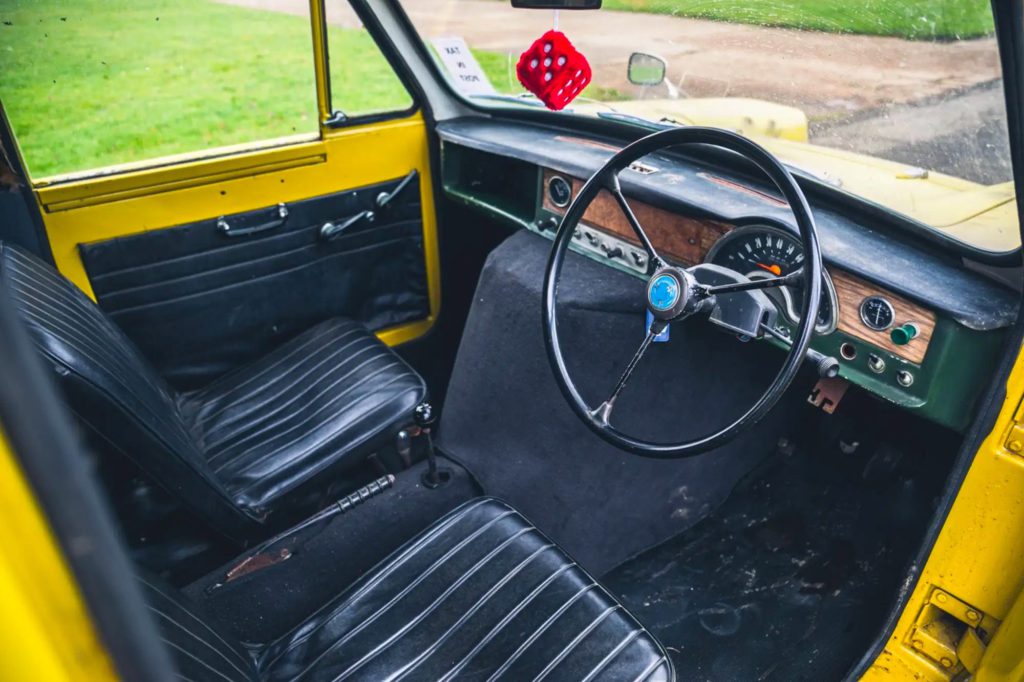
Inside the Regal Mark 7, two adults found basic but functional accommodations that prioritized practicality over comfort. The simple dashboard contained minimal gauges showing speed, fuel level, and basic warning lights in a no-nonsense layout. Bench seat vinyl upholstery offered durability rather than cushioning, with minimal padding over a simple frame. Controls included a floor-mounted gearshift, manual choke, and essential switchgear that required little explanation to operate. The steering wheel sat quite close to the driver in the compact cabin, creating a driving position that took some familiarization. When winter winds howled across Britain, you’d appreciate the basic heating system despite its limitations—it might struggle to keep you truly warm, but compared to motorcycles that dominated the same license category, the enclosed cabin felt positively luxurious to drivers who chose three wheels primarily for economic necessity rather than driving enjoyment.
33. British Motor Corporation Mini (1959) (Exterior)
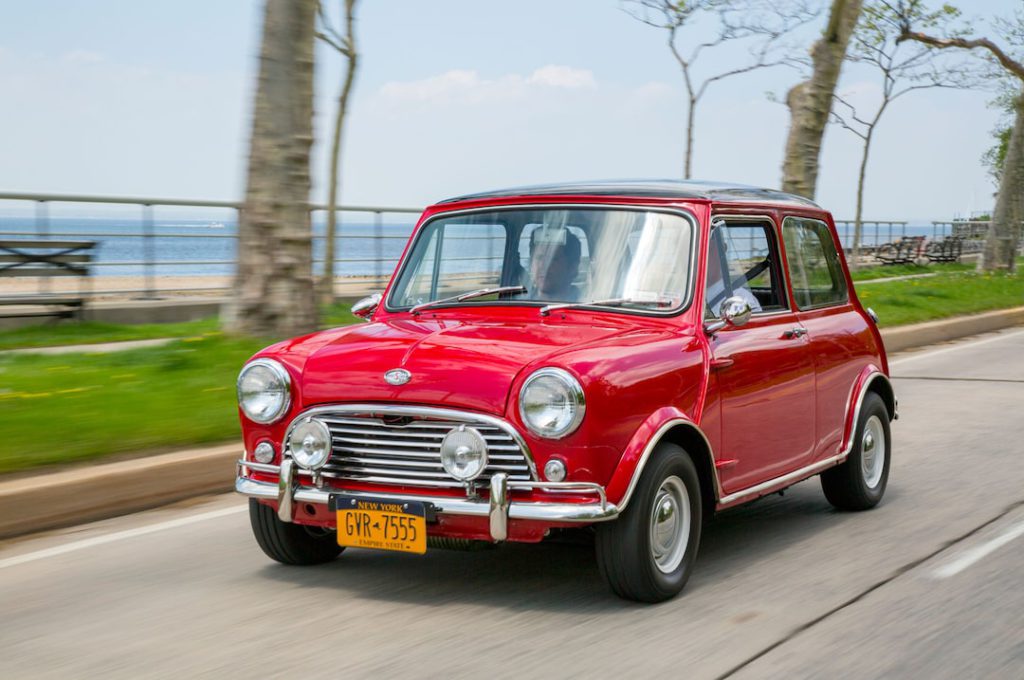
The BMC Mini shattered conventional small car thinking with its transverse engine and front-wheel drive layout. Despite its tiny 80-inch wheelbase and 120-inch total length, families found this compact box surprisingly accommodating. You could park it almost anywhere, thanks to its featherweight 1,300 pounds and diminutive footprint. Those 10-inch wheels at each corner weren’t just cute—they created the Mini’s signature stance while maximizing cabin space. Alec Issigonis cared little for fashion, designing a utilitarian shape with simple grille work and round headlights that somehow became trendy anyway. Sliding windows eliminated bulky door mechanisms, a practical solution that saved precious inches. While competitors struggled to balance style with function, the Mini’s honest approach created a template that would force the entire industry to rethink small car possibilities.
British Motor Corporation Mini (1959) (Interior)
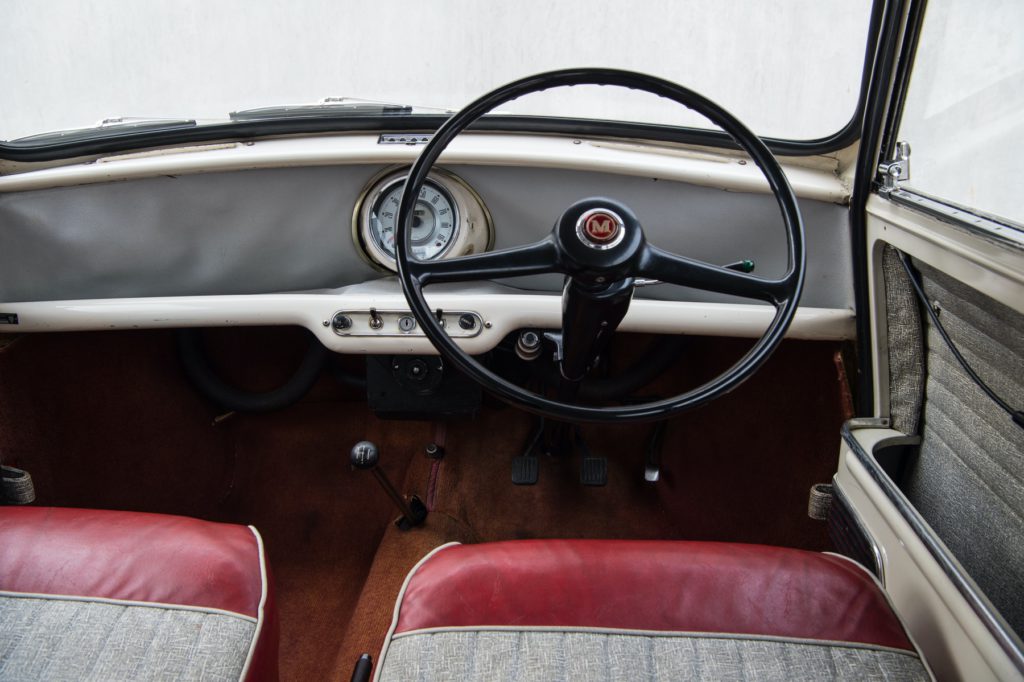
Step inside a Mini, and the tiny exterior dimensions suddenly seemed like an optical illusion. That central speedometer wasn’t just functional—it became the centerpiece of a dashboard that made every drive feel like an adventure. Clever door bins captured normally wasted space, perfect for stashing maps or snacks on your weekend escapes. Front seats kept you reasonably comfortable for hours, while the rear bench somehow accommodated two adults without requiring contortionist skills. The floor shifter snapped through gears with a satisfying precision, and those sliding windows—initially a cost-cutting measure—became a beloved quirk for owners. No other small car of the era managed to feel so spacious while taking up so little road space. When your neighbors squeezed into their Minis, they weren’t just buying transportation—they were joining a revolution that would transform urban mobility for generations.
32. Ford Anglia 105E (1959) (Exterior)

The 1959 Anglia 105E brought distinctive character to Ford UK’s lineup with its 91.5-inch wheelbase and 157.5-inch length. Its most conversation-starting feature was that backward-slanted rear window—a design element that improved headroom while creating an unmistakable profile that distinguished it from countless forgettable economy cars. The friendly face featured an oval grille with vertical bars flanked by round headlights, creating an anthropomorphic quality that made people smile. At 1,715 pounds, the Anglia remained light enough for spirited performance despite modest power. When you parked your Anglia at British seaside resorts, fellow holidaymakers would often comment on that distinctive reverse-rake window—a styling element so memorable that when the Harry Potter films needed a magical flying car decades later, the Anglia’s unique silhouette made it the perfect choice for a vehicle that was supposed to stand out from ordinary Muggle transportation.
Ford Anglia 105E (1959) (Interior)
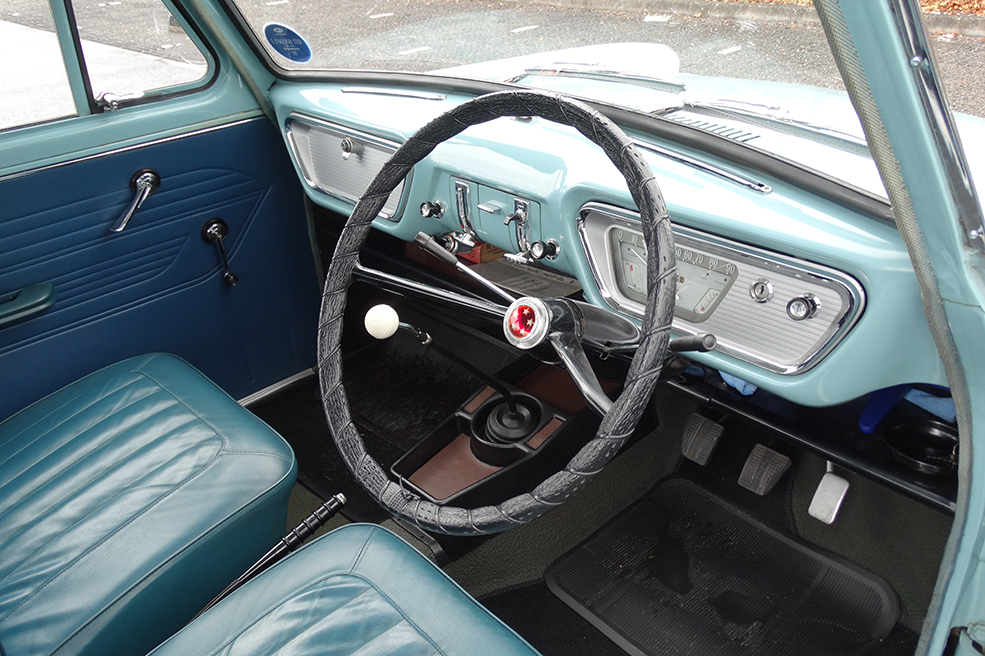
Inside, the Anglia balanced economy with touches of unexpected comfort. The dashboard arranged gauges logically with a horizontal speedometer that provided clear information at a glance. Two-tone vinyl upholstery added visual interest to the bench seats, elevating the interior beyond the purely utilitarian approach of many economy competitors. The cabin accommodated four adults without excessive crowding, though rear passengers found legroom limited on longer journeys. That distinctive backward-slanted rear window created additional headroom that tall passengers particularly appreciated. When you took friends for their first Anglia ride, they’d inevitably run their hands along the vinyl door panels and comment on how solid the little Ford felt compared to other economy cars—a testament to Ford UK’s ability to create entry-level transportation that didn’t feel like a penalty box, establishing a formula that would help make the Anglia a modest British motoring icon that remained in production until 1967.
31. Hillman Imp (1963) (Exterior)
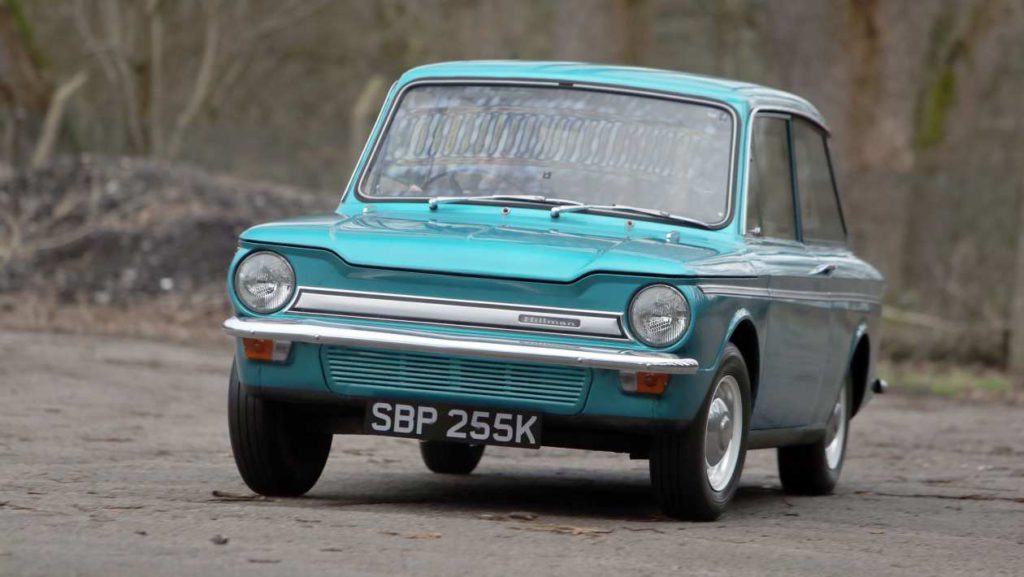
The 1963 Hillman Imp introduced innovative engineering to Britain’s small car market with its 81.5-inch wheelbase and 139-inch length. Unlike most competitors, the Imp positioned its aluminum engine at the rear, creating distinctive proportions with a short hood and longer rear deck. The clean-sided body featured minimal ornamentation, with simple chrome trim highlighting grille and window surrounds. Large windows provided exceptional visibility in all directions, with a particularly generous rear window that made parallel parking less stressful than in many larger vehicles. At 1,720 pounds, the lightweight body enhanced performance despite modest displacement. When you drove an Imp spiritedly along winding country lanes, its responsive handling revealed the Rootes Group’s ambition to create not just basic transportation but a driver’s car for the masses—a British answer to the rear-engined Volkswagen that added a dash of sporting character to the economy car formula.
Hillman Imp (1963) (Interior)
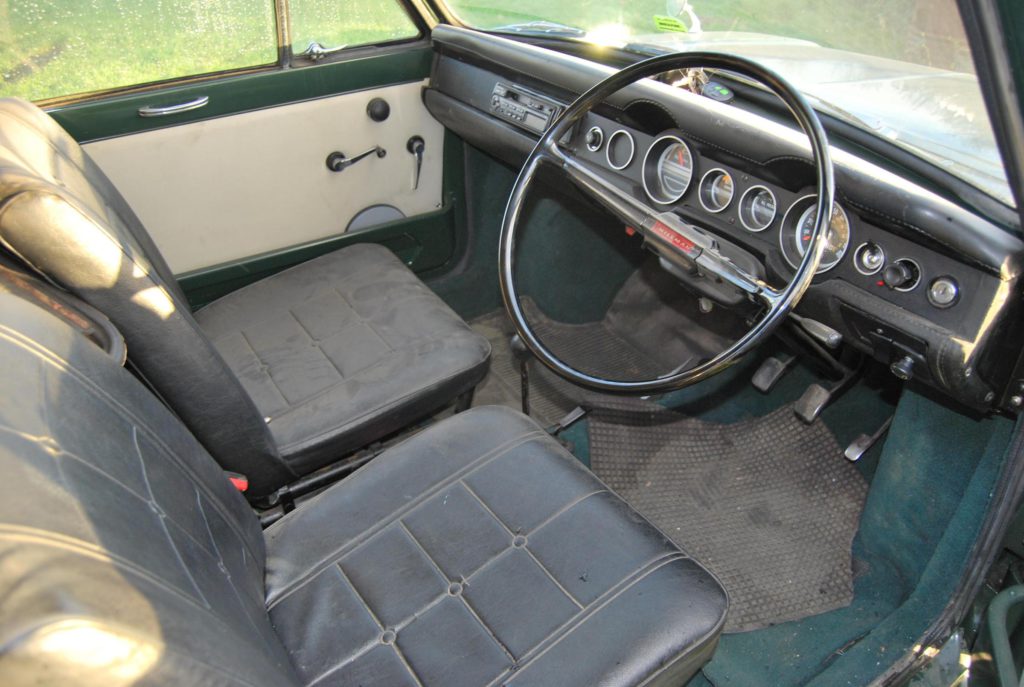
The Imp’s cabin demonstrated thoughtful design that maximized space efficiency while adding touches not found in most economy competitors. The dashboard positioned the speedometer directly ahead of the driver, with auxiliary gauges grouped nearby for quick reference without distraction. Front seats provided better lateral support than many contemporaries, holding you in place during cornered maneuvers. With the engine relocated to the rear, the front compartment housed a surprisingly large luggage area—an arrangement that confused first-time passengers expecting to find storage in the back. The floor-mounted shifter operated with precision uncommon in economy cars, connecting you directly to the mechanical components. When you showed friends your new Imp, they’d inevitably be surprised by thoughtful details like the opening rear window for ventilation and the quality of switchgear—evidence that Rootes Group aimed higher than basic transportation despite the Imp’s modest price point and economy car classification.
30. Vauxhall Viva (1963) (Exterior)
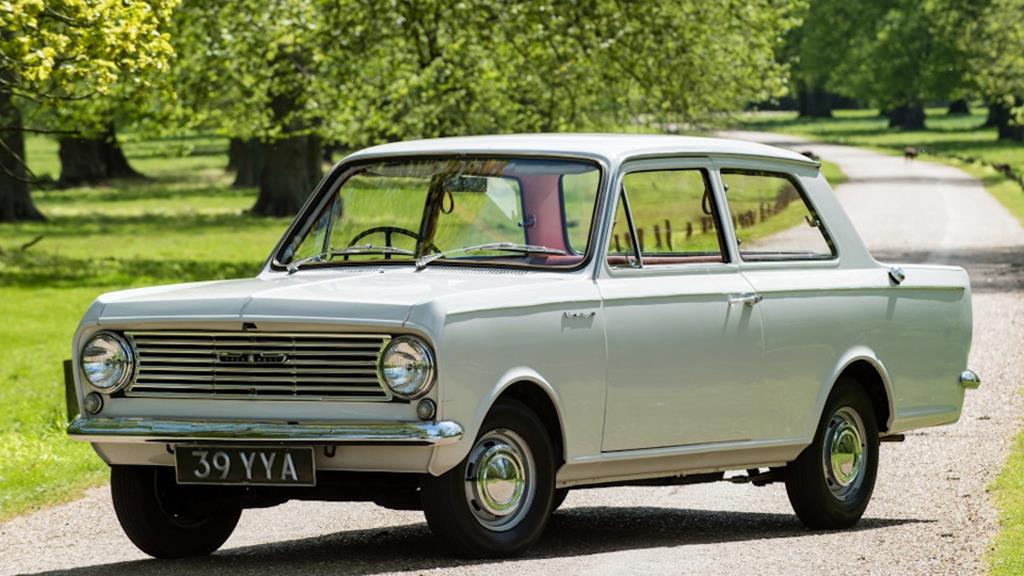
The 1963 Viva introduced clean, modern styling to Vauxhall’s lineup with its 96-inch wheelbase and 156-inch length. The design avoided decoration for its own sake, featuring smooth body sides with subtle contours rather than chrome add-ons or gratuitous details. The front incorporated a simple horizontal grille flanked by round headlights, creating an approachable face that appealed to practical family buyers. At approximately 1,700 pounds, the lightweight unibody enhanced both performance and efficiency. Large glass areas with thin pillars ensured excellent visibility that drivers of today’s thick-pillared cars would envy. When you parked your Viva alongside the more flamboyant designs still common in the early 1960s, its clean lines made those vehicles suddenly look dated—evidence that British automotive design was evolving toward the more functional aesthetic that would dominate the following decade, with the Viva helping lead that transition.
Vauxhall Viva (1963) (Interior)
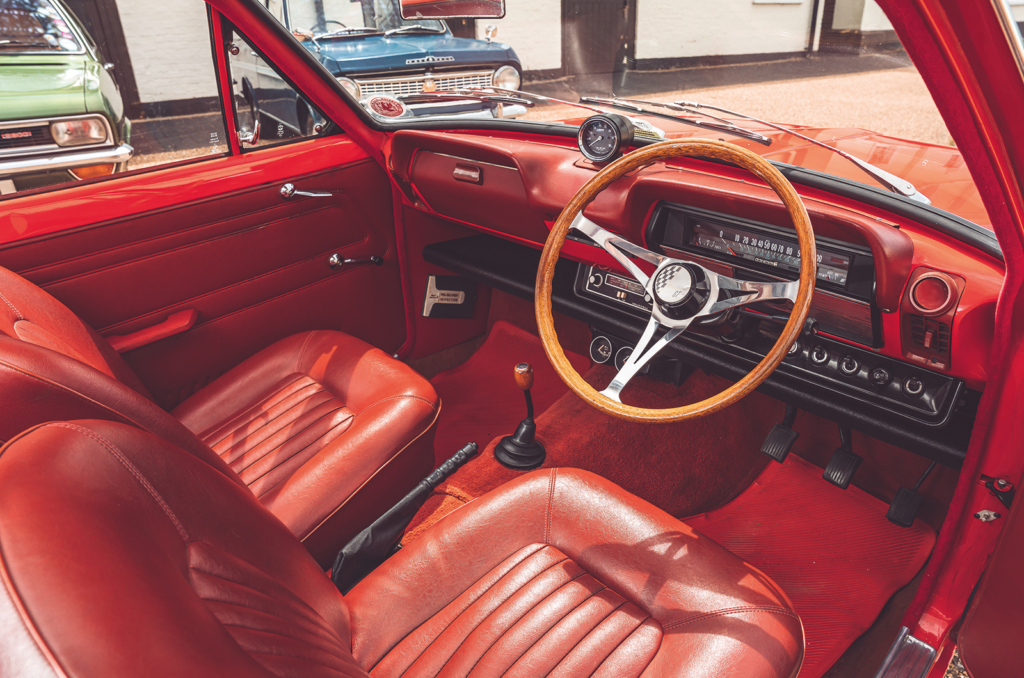
Inside, the Viva emphasized practical comfort with straightforward design elements chosen for function rather than flash. The dashboard featured a horizontal speedometer with clear markings and logical control placement that required no owner’s manual consultation to operate. Bench seats came covered in vinyl upholstery selected for durability rather than luxury appearances. A full-width parcel shelf below the dashboard provided useful storage for maps, gloves, and other essentials within easy reach of both driver and passenger. Controls operated with a satisfying mechanical precision that suggested durability beyond the car’s modest price point. When you took delivery of your new Viva, the dealer would inevitably point out thoughtful touches like the comprehensive ventilation system and easy-to-clean interior surfaces—features that mattered in real-world family use far more than the styling gimmicks emphasized by many competitors, helping explain why the Viva found homes with practical British families who valued substance over show.
29. Austin A40 Farina Mark II (1961) (Exterior)
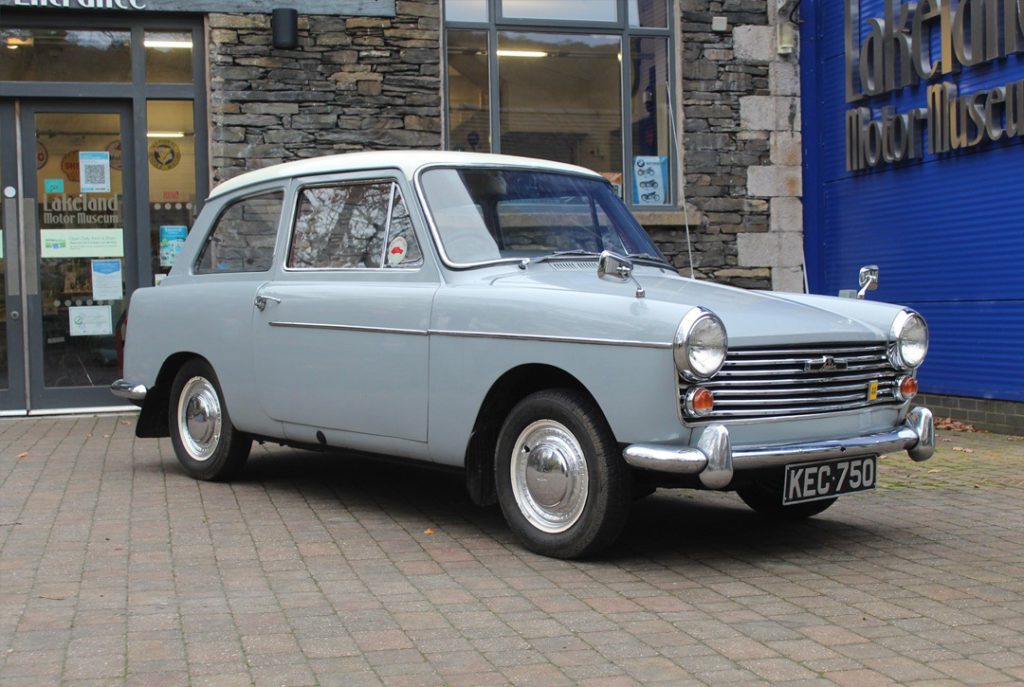
The 1961 A40 Farina Mark II showcased Italian design influence within its modest 83.5-inch wheelbase and 145-inch length. Penned by Pininfarina, the A40 featured clean proportions that looked more sophisticated than its budget price suggested. The tailgate incorporated a novel two-part design that opened either as a conventional trunk lid or as a complete hatchback—pioneering the hatchback concept years before it became industry standard. At approximately 1,600 pounds, the lightweight body enhanced both performance and efficiency despite modest engine output. When you pulled up to British shops in your A40, its Italian-designed body drew admiring glances not typically afforded to economy cars—evidence that good design needn’t be expensive, while establishing a template for the practical hatchback configuration that would eventually dominate European small car design and influence manufacturers worldwide.
Austin A40 Farina Mark II (Interior)

The A40’s cabin balanced British practicality with Italian design influence in a way that elevated the everyday driving experience. The dashboard arranged gauges and controls logically without unnecessary complication or wasted space. Two-tone vinyl upholstery added visual interest to the bench seats, with attractive patterns reflecting Pininfarina’s aesthetic influence that made the interior feel more special than its price point suggested. The innovative dual-action tailgate created cargo versatility decades ahead of its time, expanded further by folding the rear seat to create a flat load floor. When you demonstrated the A40’s transformable rear compartment to friends, they’d invariably be impressed by its clever utility—a feature now taken for granted in modern hatchbacks but revolutionary when most cars maintained rigid distinctions between sedans and wagons, demonstrating how thoughtful design could solve practical problems without adding significant manufacturing cost.
28. Morris Minor (1962) (Exterior)
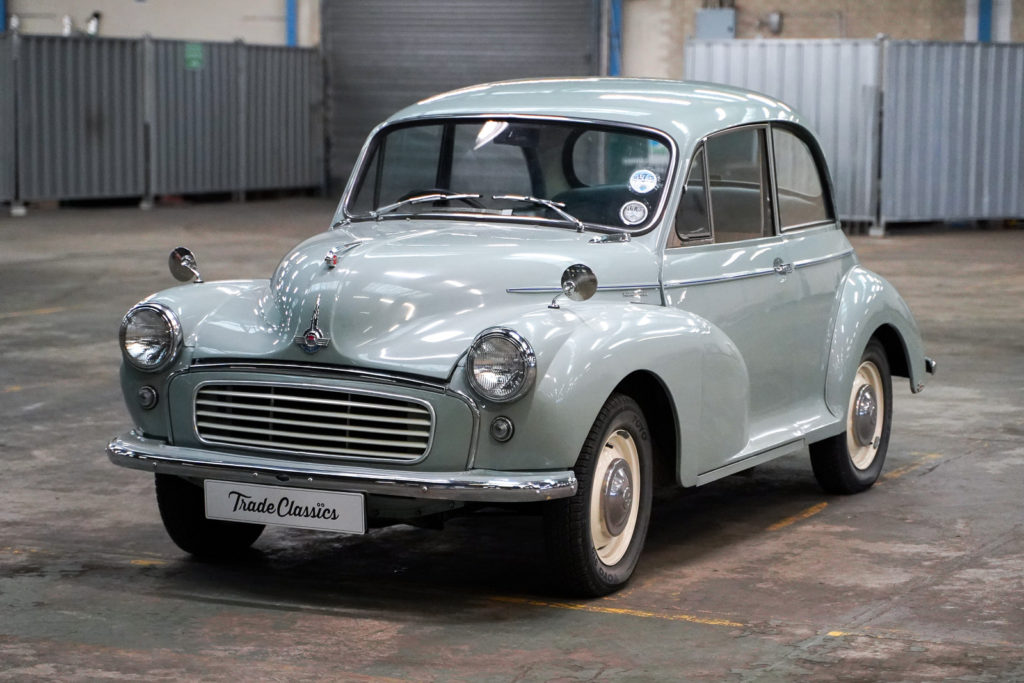
The 1962 Minor continued its successful run with the familiar rounded shape that had become a fixture on British roads. Built on an 86-inch wheelbase and measuring 148 inches in length, the Minor maintained its approachable, almost anthropomorphic character that made people smile. The front featured a simple grille flanked by headlights either freestanding on fenders or integrated into the body, depending on production year. Body options included two-door and four-door sedans, a convertible, and the beloved Traveller wagon with its distinctive wood-framed rear section that added visual warmth. At around 1,700 pounds, the Minor remained lighter than many competitors despite its aged design. When you drove a Minor through British villages, you’d receive waves from fellow owners—part of an informal club that appreciated the car’s honest character and mechanical simplicity during an era when automotive design was becoming increasingly complex and sometimes unnecessarily so.
Morris Minor (Interior)

Inside, the Minor offered straightforward functionality with traditional British character that prioritized clarity over gimmicks. The dashboard positioned a central speedometer with essential gauges grouped in a simple pod directly in your line of sight. Bench seats in vinyl or optional leather provided adequate comfort despite limited padding, supporting you sufficiently for day-long drives across the British countryside. The driving position placed the large steering wheel closer to your chest than modern designs, creating an intimacy with the mechanical components that made driving feel like a proper activity rather than a passive experience. When you took friends for country drives in your Minor, the conversation inevitably turned to its honest simplicity—a quality increasingly rare as cars became more complicated, helping explain why so many Minors remained on the road decades beyond their expected service life, preserved by owners who valued their unpretentious functionality in an automotive world increasingly focused on style over substance.
27. Citroen Ami (1961) (Exterior)

The 1961 Ami built upon Citroen’s established 2CV platform with more sophisticated styling across its 94.5-inch wheelbase and 157-inch length. Unlike its deliberately utilitarian cousin, the Ami featured more conventional proportions highlighted by unique inverted trapezoid headlights that became its most distinctive and controversial styling element. The front incorporated a simple grille with Citroen’s double-chevron emblem, while the sides featured clean, uncluttered lines that avoided unnecessary decoration. At just 1,367 pounds, the Ami remained light enough for adequate performance despite modest power output. When you drove through French villages in your new Ami, locals would immediately recognize it as the more upscale 2CV alternative—a car for families who appreciated Citroen’s engineering approach but required more refinement than the basic 2CV could provide, establishing a market position that would later be filled by the wildly successful Dyane and eventually the modern C3.
Citroen Ami (Interior)
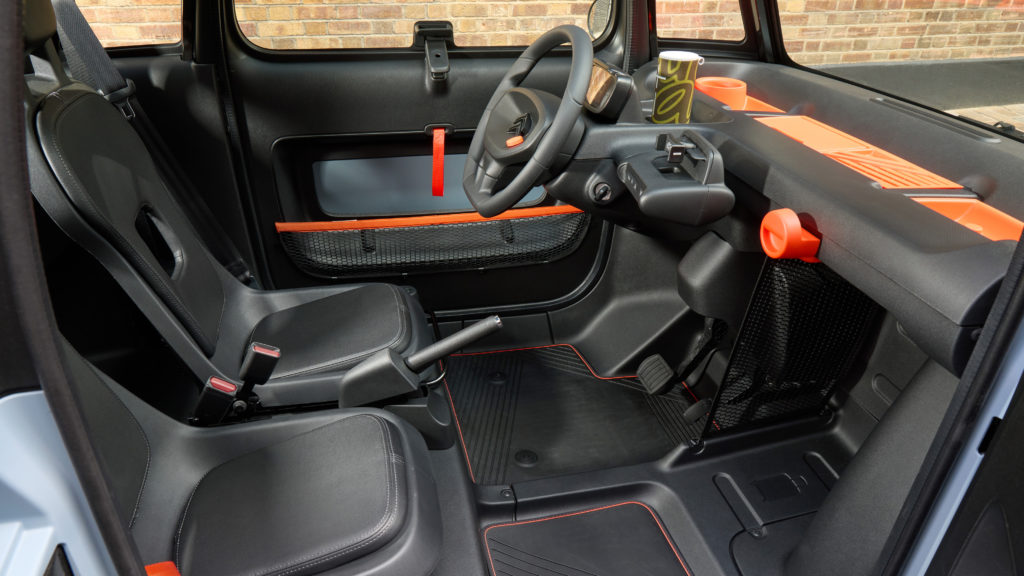
The Ami’s interior represented a significant advancement from the spartan 2CV while maintaining Citroen’s function-first philosophy. The dashboard arranged simple gauges and controls in a straightforward layout that prioritized usability over style. The single-spoke steering wheel continued Citroen’s distinctive design language while providing clear instrument visibility without obstruction. Front bench seating offered improved comfort with additional padding compared to the hammock-like seats of the minimalist 2CV. The gear shifter emerged from the dashboard rather than the floor—a quirky solution you’d quickly grow to appreciate for its ease of use. When you welcomed passengers into your Ami for the first time, they’d inevitably comment on how much more “civilized” it felt compared to the basic 2CV, while still maintaining the character that made French cars distinct from their German and British competitors—proof that Citroen understood how to move upmarket without abandoning the practical ingenuity that defined their engineering approach.
26. Renault R3/R4 (1961) (Exterior)
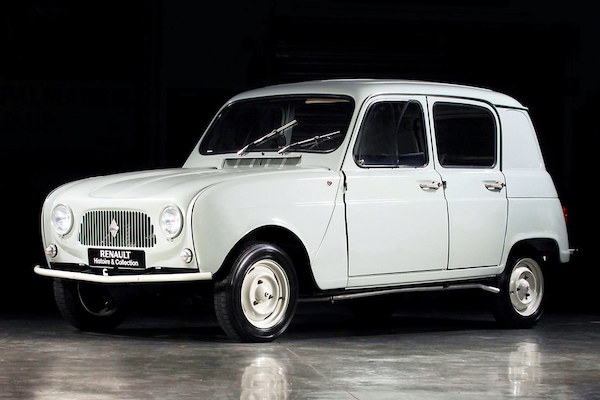
The 1961 Renault R3 and R4 introduced practical hatchback versatility on an 89.4-inch wheelbase and 142-inch length—dimensions that maximized interior space while remaining easy to park anywhere in crowded European cities. Their two-box design prioritized function over styling flourishes at a time when many manufacturers still struggled to abandon decorative excesses. The front featured a simple grille with the Renault diamond logo and rectangular headlights integrated into the fenders. Front-hinged doors replaced the suicide doors of earlier Renaults, addressing safety concerns while improving entry and exit. At approximately 1,300 pounds, the lightweight body enhanced efficiency from modest power. When you navigated Paris traffic in your R4, its tall greenhouse and commanding seating position gave you confidence that larger cars couldn’t match—establishing a practical template that would influence not just future Renaults but the entire European approach to small, space-efficient family cars for decades to come.
Renault R4 (Interior)
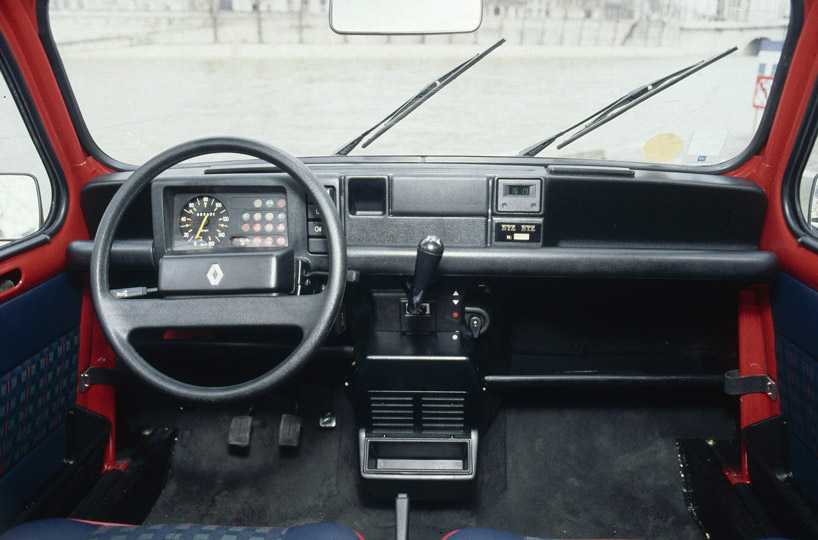
Inside, the R4 prioritized versatility with a highly functional layout that European families quickly came to appreciate. The dashboard contained minimal instrumentation with a central speedometer and essential warning lights in a simple pod that told you what you needed to know without distraction. Controls featured a dashboard-mounted gear shifter operating the four-speed transmission through an unusual push-pull-twist pattern that became second nature after a few days of ownership. The front bench provided basic comfort with adequate support for city driving and occasional longer journeys. The rear bench could fold or be completely removed, creating a flat load floor that transformed your compact car into a miniature delivery van when needed. When neighbors saw you loading impossibly large furniture pieces into your tiny R4, they’d marvel at its tardis-like interior volume—a practical advantage that helped make the R4 one of Renault’s most successful models globally with over eight million produced across a remarkable 31-year production run.
25. Simca Aronde P60/Simca 5 (1964) (Exterior)
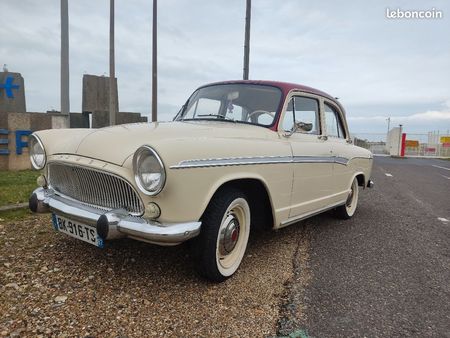
French engineering defined the Simca Aronde P60 with its 165-inch length and 96.5-inch wheelbase. The compact sedan maintained clean body lines complemented by subtle chrome accents and distinctive round headlights. Its horizontal slat grille design visually widened the car’s front profile. Weighing just 2,000 pounds, the P60 proved nimble through urban environments while offering practical transportation for families. Under the hood, the 1290cc “Flash” engine delivered 57 horsepower and 70 lb-ft of torque – sufficient to reach a top speed of 81 mph and accelerate from 0-60 mph in 20 seconds. The Aronde’s front suspension used independent coil springs, while the rear employed a conventional leaf spring setup typical of the era. When Chrysler acquired Simca in 1963, they inherited this successful design that had helped transform personal mobility across post-war France.
Simca Aronde P60/Simca 5 (1964) (Interior)
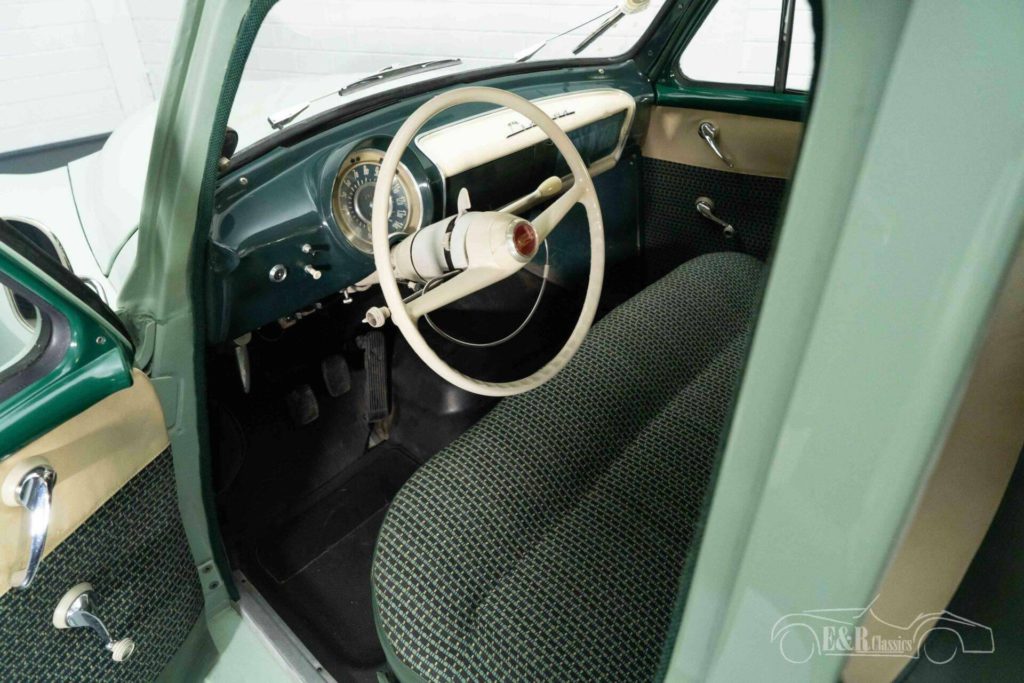
Straightforward functionality characterized the Aronde P60’s cabin. Simple round gauges displayed essential information with clear markings for speed and engine temperature. The modest dashboard housed basic controls within easy reach of the driver. Front bucket seats provided adequate support by 1960s standards, while the rear bench accommodated three adults on shorter journeys. The four-speed manual transmission operated through a floor-mounted shifter with reasonably precise action. Minimal sound insulation meant engine and road noise remained noticeable companions during highway travel. Interior materials focused on durability rather than luxury, with vinyl upholstery covering the seating surfaces. Heater performance proved adequate for most conditions, though ventilation relied primarily on wind-wing windows and dash-mounted vents. Should you find yourself in a restored Aronde today, you’d immediately notice how it represents the transition between post-war austerity and the creature comforts we now take for granted.
24. Messerschmitt KR200 (1964) (Exterior)

Aircraft manufacturing heritage shaped the Messerschmitt KR200, a microcar with an unmistakable design. Measuring just 111 inches long with an 80.3-inch wheelbase, this three-wheeler turned heads wherever it appeared. The incredibly light 507-pound body housed a tandem seating arrangement under a distinctive plexiglass canopy that hinged sideways for entry. Unlike conventional cars, the front wheel turned a complete 180 degrees, creating an exceptionally tight turning radius. Power came from a 191cc single-cylinder two-stroke engine generating just 10 horsepower – modest output that nonetheless propelled this lightweight oddity to a top speed of 56 mph. The KR200 emerged from post-war material restrictions when fuel economy took precedence over size and comfort. Far from being a footnote in automotive history, this quirky three-wheeler inspired a cult following that persists among collectors who appreciate its ingenious solution to post-war mobility challenges.
Messerschmitt KR200 (Interior)
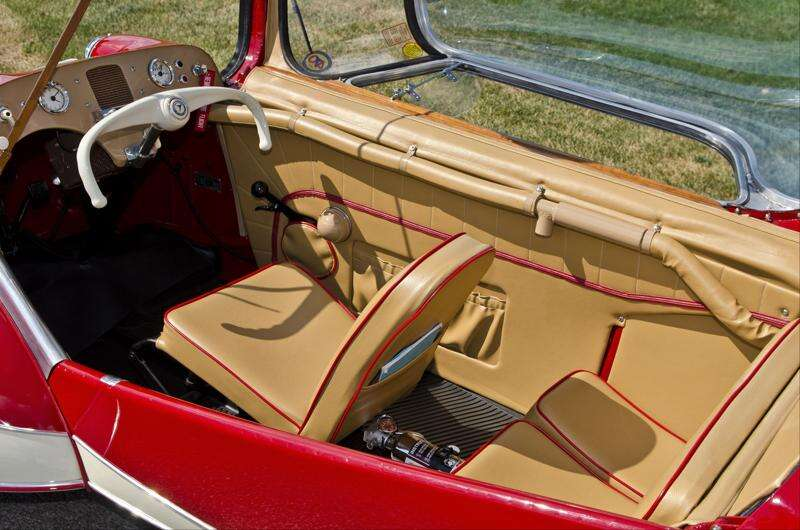
Unconventional thinking defined the KR200’s interior experience. Tandem seating positioned driver and passenger in fighter pilot fashion, one behind the other rather than side-by-side. Controls deviated from automotive norms with a motorcycle-style handlebar replacing the traditional steering wheel. The four-speed transmission operated through a floor-mounted stick with no reverse gear – the engine simply ran backward when needed. Occupants enjoyed unparalleled visibility through the bubble-like canopy, though sunny days quickly transformed the interior into a greenhouse without effective ventilation. Storage space barely existed beyond small pockets for essentials. The dashboard contained minimal instrumentation with just basic speed and engine information. Climb into a KR200 today and you’ll immediately understand why owners joke they’re “wearing” rather than “driving” this peculiar vehicle – an intimate connection between human and machine unmatched by conventional automobiles.
23. Glas Isar (1960) (Exterior)
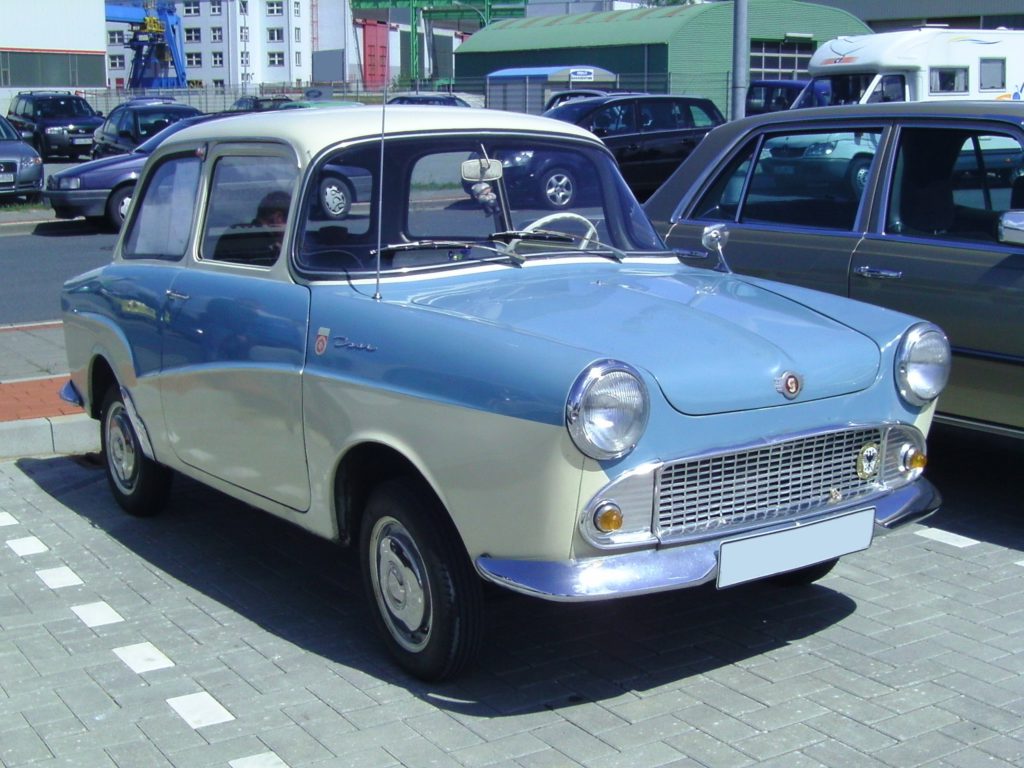
Bavarian manufacturer Glas offered the Isar as their entry in the growing microcar segment. Spanning just 141.7 inches on an 86.6-inch wheelbase, this compact German car balanced minimal dimensions with everyday practicality. Available in both Coupe and Combi wagon versions, the Isar featured an upright stance with circular headlights and modest chrome trim. The lightweight 1,433-pound body housed either a 296cc two-cylinder two-stroke producing 15 horsepower or a larger 392cc version generating 20 horsepower. Top speed reached a modest 56 mph – adequate for urban environments but challenged on highways. The Isar’s front-mounted engine powered the rear wheels through a conventional drivetrain layout. Before BMW absorbed Glas in 1966, this modest compact helped establish the manufacturing foundation that would later produce the elegant Glas GT sports coupe – proving that humble beginnings can lead to remarkable destinations.
Glas Isar (Interior)
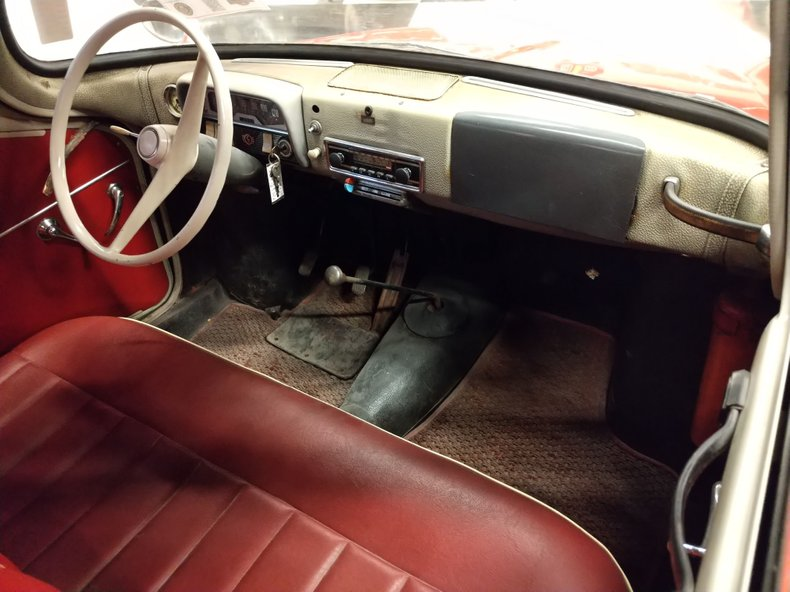
Functional minimalism dominated the Glas Isar’s cabin design. The basic dashboard housed essential instrumentation behind a simple three-spoke steering wheel positioned for comfortable reach. Front bucket seats offered limited adjustment but provided adequate support for typical commuting distances. Rear passengers found reasonable accommodation on a bench seat, while the Combi wagon variant significantly expanded cargo capacity with folding rear seats. The four-speed manual transmission operated through a floor-mounted shifter with reasonably direct action. Interior materials emphasized durability over comfort, with hard-wearing surfaces throughout the cabin. The two-stroke engine’s distinctive sound permeated the interior during acceleration due to minimal sound insulation. Heating capacity proved adequate for German winters, though defrosting required patience on particularly cold mornings. If you’d driven an Isar back in the day, you’d have appreciated its honest simplicity – a refreshing counterpoint to today’s button-laden dashboards and touchscreen complexities.
22. Lloyd Arabella (1962-1965) (Exterior)
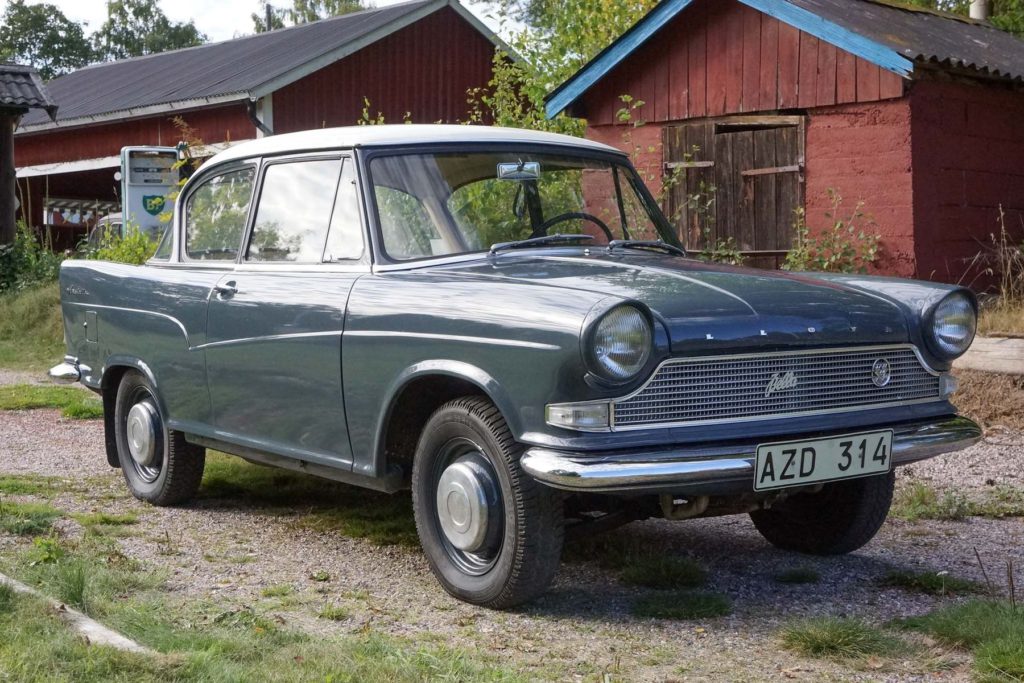
German innovation powered the Lloyd Arabella with a design emphasizing modern efficiency. Spanning 157.5 inches on a 94.5-inch wheelbase, this compact sedan featured clean styling with gentle curves and a generous greenhouse for excellent visibility. The lightweight 1,543-pound body incorporated advanced engineering including unibody construction and four-wheel independent suspension – unusual features for its price class. Under the hood, a water-cooled 897cc four-cylinder engine delivered 45 horsepower, propelling the Arabella to a top speed of 78 mph. Front disc brakes provided stopping power beyond most competitors’ drum setups. The Arabella represented a significant engineering achievement for Lloyd, though production challenges and quality issues limited its success. While financial problems ultimately doomed Lloyd’s ambitious vision, the Arabella’s forward-thinking features foreshadowed engineering approaches that would become industry standards decades later.
Lloyd Arabella (1962-1965) (Interior)
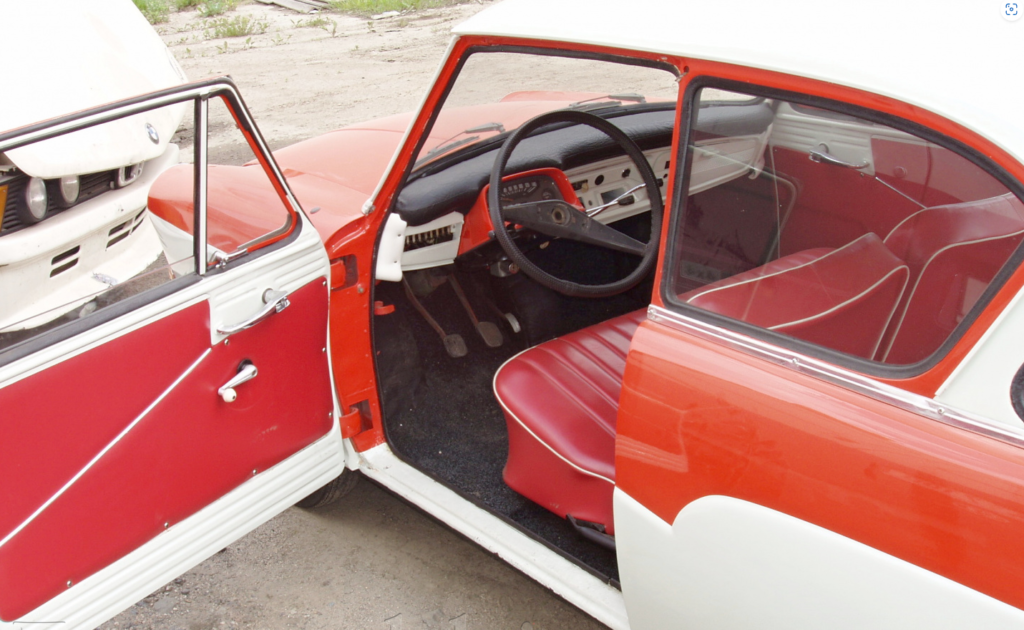
Thoughtful design elevated the Arabella’s cabin above typical economy car standards. The horizontal dashboard layout placed clearly marked instruments directly in the driver’s line of sight. A two-spoke steering wheel fronted these gauges with comfortable positioning for extended driving. Front bucket seats and a rear bench accommodated four adults with reasonable comfort for the vehicle’s size class. The four-speed manual transmission featured synchromesh on the top three gears, operated through a floor-mounted shifter. Interior storage included practical door pockets and a modest glove compartment. Heating and ventilation systems performed effectively even in cold German winters. The water-cooled engine ran more quietly than air-cooled alternatives common in economy cars of the period. Sit in an Arabella today and you’d be forgiven for thinking you’re in a car from a decade later – its sophisticated cabin environment represents one of automotive history’s “what might have been” moments had Lloyd survived its financial struggles.
21. NSU Prinz 4 (Exterior)
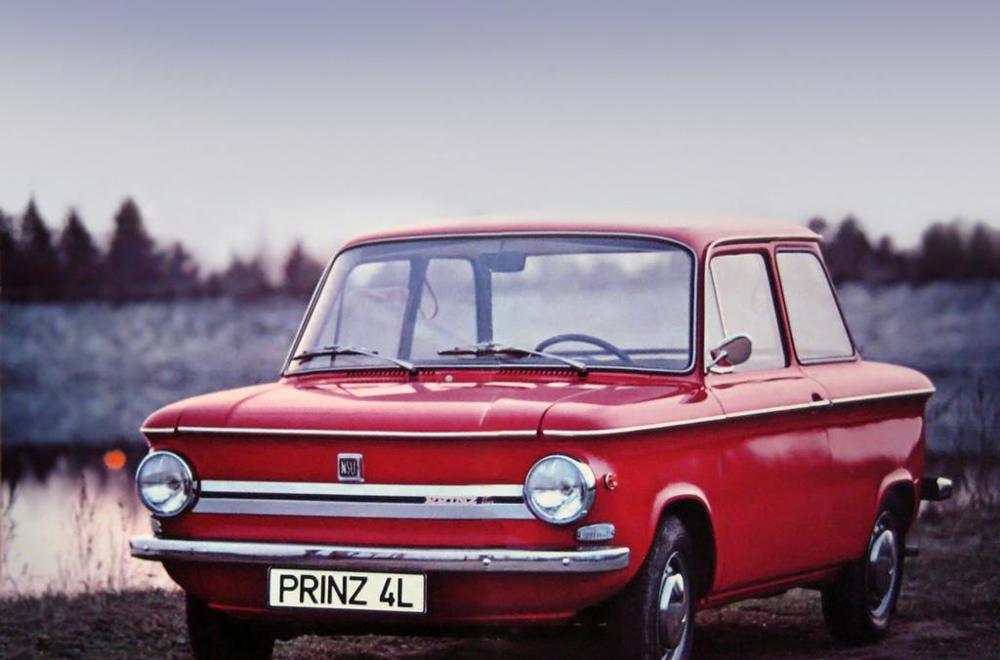
American styling influences shaped the NSU Prinz 4 despite its German engineering origins. Measuring 141.7 inches over an 85.8-inch wheelbase, this compact featured design elements clearly inspired by the Chevrolet Corvair. Large windows wrapped around the cabin, providing excellent visibility from all angles. The lightweight 1,323-pound body housed a rear-mounted, air-cooled 598cc two-cylinder engine producing 30 horsepower and 31 lb-ft of torque. This modest powerplant pushed the Prinz to a top speed of 71 mph while taking a leisurely 33 seconds to reach 60 mph. The rear-engine layout maximized interior space while creating distinctive handling characteristics. Peek beneath a Prinz 4’s engine cover today and you’ll discover the mechanical simplicity that allowed owners to perform most maintenance with basic tools – a stark contrast to today’s computer-controlled powerplants that baffle amateur mechanics.
NSU Prinz 4 (Interior)
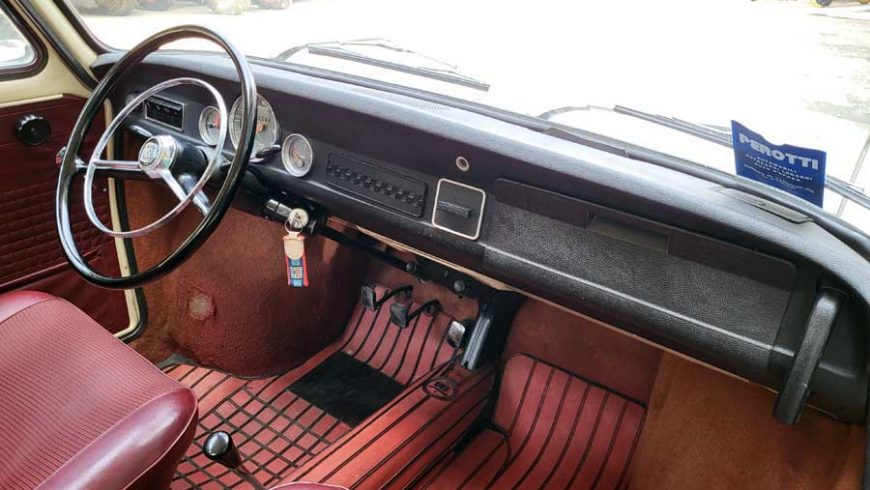
Smart packaging created surprising spaciousness inside the Prinz 4 despite its compact external dimensions. The rear-engine layout allowed for a completely flat floor, maximizing usable interior space. A simple horizontal speedometer dominated the instrument panel, supplemented by basic warning lights for essential functions. Front bucket seats provided adequate support, while the rear bench accommodated two additional passengers in reasonable comfort. The four-speed manual transmission operated through a floor-mounted shifter with direct mechanical linkage to the rear-mounted gearbox. Hard-wearing vinyl covered the seating surfaces while minimizing maintenance requirements. Front trunk space compensated somewhat for the engine’s rear placement, providing storage for smaller items. You might chuckle at the air-cooled engine’s distinctive soundtrack, but this characteristic buzz became a fond memory for many owners – a mechanical signature that announced your arrival long before you came into view.
20. Volkswagen Beetle (Early 1960s) (Exterior)

Cultural phenomenon status elevated the Volkswagen Beetle beyond mere transportation. The early 1960s saw this German compact enjoy unprecedented success in North America with its distinctive rounded silhouette becoming instantly recognizable worldwide. The air-cooled, rear-mounted 1192cc flat-four engine produced a modest 40 horsepower and 64 lb-ft of torque, sufficient for steady progress if not outright speed. For the 1962 model year, the Beetle received larger taillights, improving visibility and safety. Weighing approximately 1,600 pounds with a 94.5-inch wheelbase, the Beetle’s simple yet effective engineering prioritized reliability over performance. The rear-engine layout provided excellent traction on slippery surfaces while creating the car’s characteristic handling traits. Unlike most competitors that underwent complete redesigns every few years, the Beetle evolved through subtle annual refinements that preserved its essential character. When you spot a Beetle today, you’re witnessing automotive history’s greatest survivor – a design that transcended its utilitarian origins to become a global cultural touchstone.
Volkswagen Beetle (Interior)

Functional minimalism defined the Beetle’s cabin with a focus on simplicity rather than gadgetry. The basic dashboard featured a large speedometer flanked by fuel gauge and warning lights, with minimal controls for essential functions. Front bucket seats provided adequate support while the small rear bench accommodated two passengers in tight quarters. The four-speed manual transmission operated through a floor-mounted shifter with long throws but precise engagement. Interior materials emphasized durability over luxury with painted metal surfaces dominating the door panels and dashboard areas. The front trunk offered modest storage capacity, supplemented by space behind the rear seat. Heating relied on air ducted from the engine’s cooling system – effective in mild conditions but famously inadequate in severe winter weather. You might smile at the Beetle’s quirky deficiencies today, but these character-building traits helped forge the deep emotional connections that transformed ordinary owners into lifelong enthusiasts – proving that imperfection sometimes creates more lasting appeal than polished perfection.
19. BMW 700 (1959-1964) (Exterior)
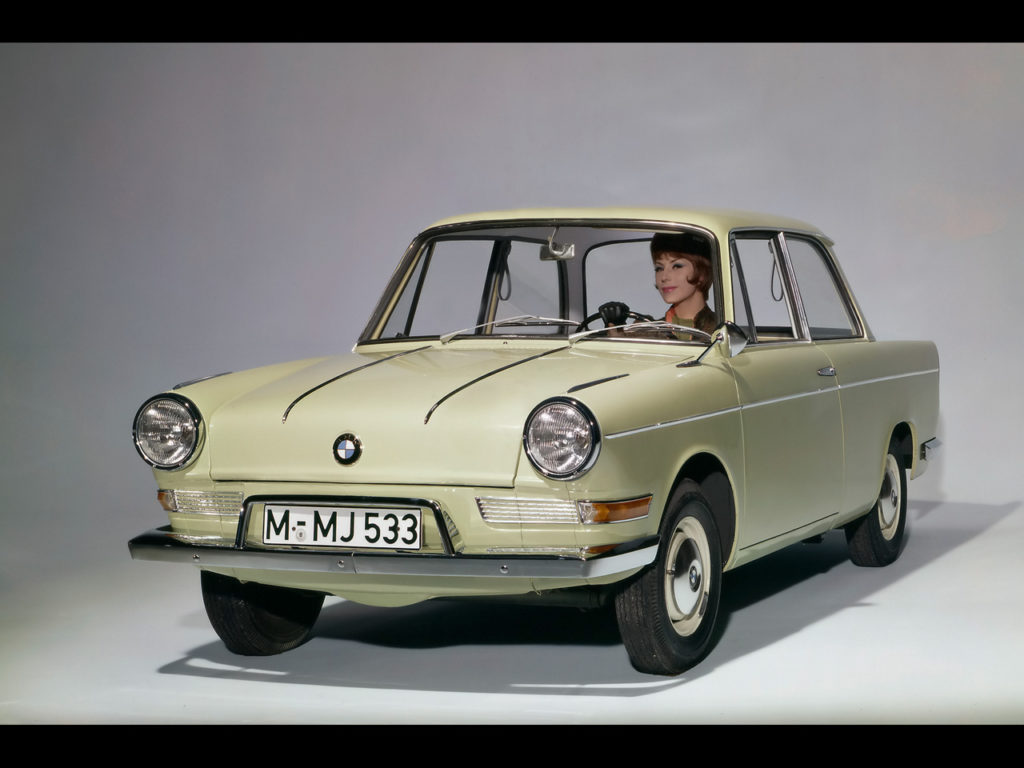
Corporate salvation came in the form of BMW’s 700 model, a car that helped pull the company back from financial collapse. Compact dimensions of 138 inches on an 82.7-inch wheelbase housed clean styling with distinctive round headlights and BMW’s signature kidney grille in miniature form. The 1,411-pound vehicle came in sedan, coupe, and convertible variants to suit different buyer needs. Power flowed from a rear-mounted, air-cooled 697cc two-cylinder boxer engine producing 32 horsepower and 42 lb-ft of torque. This modest output still delivered surprising performance with a top speed of 78 mph and 0-60 mph acceleration in 23 seconds. The rear-engine design created unique weight distribution that influenced handling characteristics. Without the 700’s commercial success generating crucial revenue, we might live in a world without BMW’s later sporting sedans – a sobering thought for enthusiasts who cherish the brand’s driver-focused philosophy.
BMW 700 (1959-1964) (Interior)
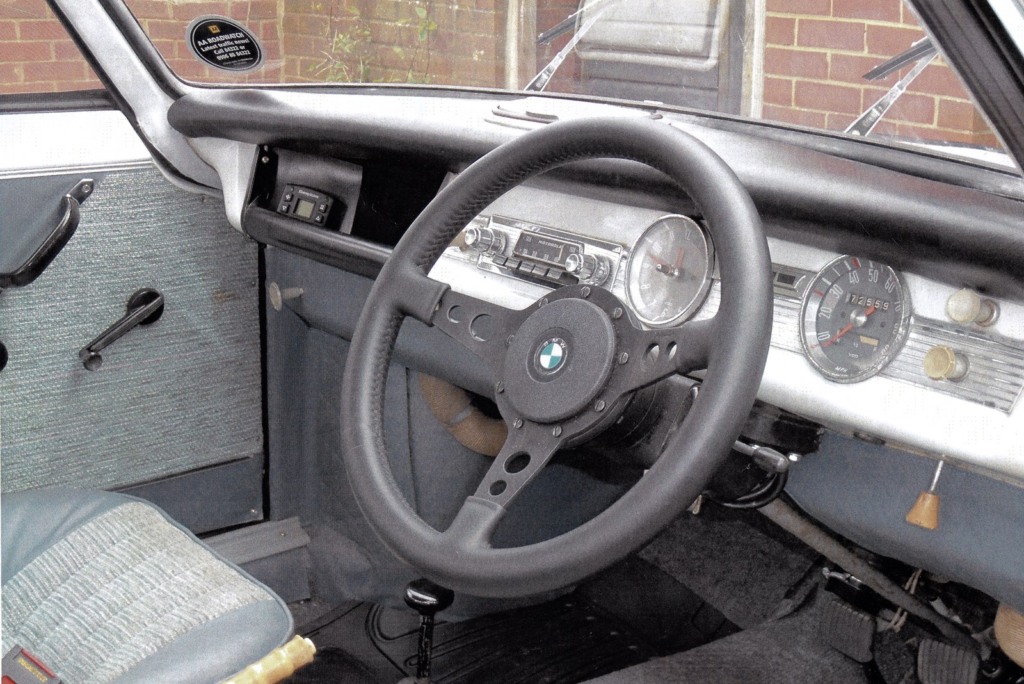
German engineering efficiency defined the 700’s cabin layout. Simple, logical instrumentation placed essential information directly in front of the driver with secondary controls within easy reach. The no-nonsense dashboard housed round gauges with clear markings for critical functions. Front bucket seats offered good support for extended driving sessions, while the rear bench accommodated two adults in adequate comfort despite the car’s compact dimensions. The four-speed manual transmission operated through a floor-mounted shifter with mechanical precision that foreshadowed BMW’s later reputation for driver-focused controls. Materials quality exceeded many economy competitors with attention to durability and assembly standards. The rear-mounted engine configuration created a useful front trunk compartment for luggage. Drive a 700 today and you’ll discover the engaging handling characteristics that presaged BMW’s later “Ultimate Driving Machine” identity – proving that driving enjoyment doesn’t require massive horsepower or complicated electronics.
18. Opel Kadett (1962) (Exterior)
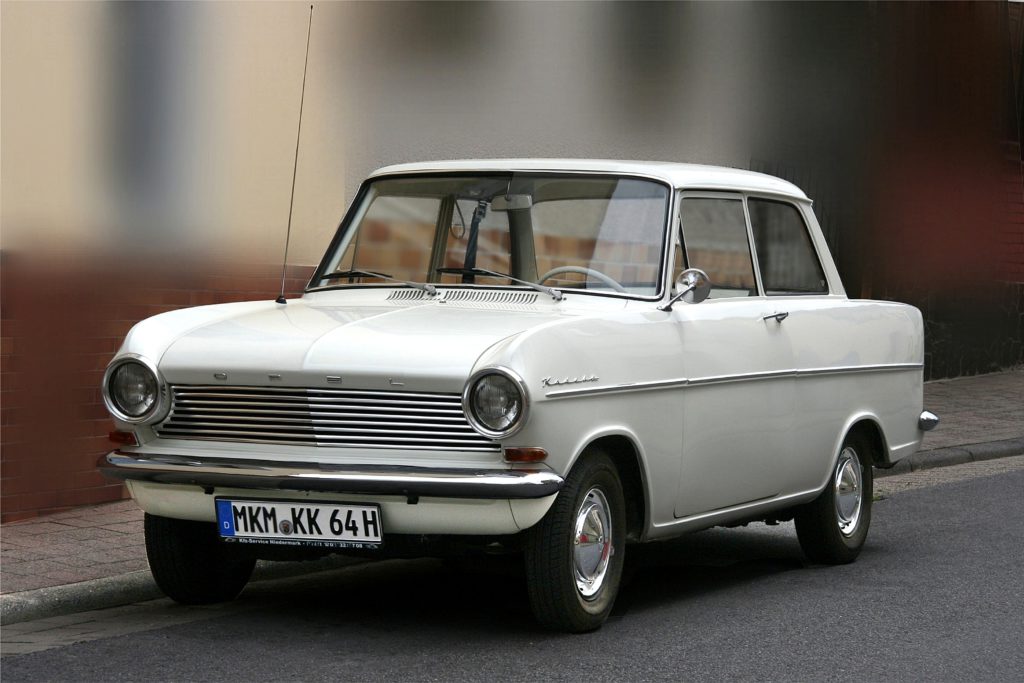
General Motors’ German division created the Opel Kadett as their compact contender against the Volkswagen Beetle. Measuring 156.7 inches on a 92.5-inch wheelbase, the Kadett featured crisp, modern styling with clean lines and ample glass area. Weighing just 1,576 pounds, this conventional front-engine, rear-drive compact offered practical transportation with balanced handling characteristics. A 993cc inline-four engine generated 40 horsepower and 54 lb-ft of torque, sufficient for a top speed of 75 mph and 0-60 mph acceleration in 27 seconds. The Kadett’s conventional mechanical layout simplified maintenance compared to rear-engine competitors. Introduced in 1962, the model quickly found market acceptance with 647,000 units sold by 1965. The Kadett name would become one of Opel’s enduring nameplates, spanning multiple generations and establishing a continuous compact car lineage that eventually evolved into today’s Astra – demonstrating how a successful foundation can sustain decades of development.
Opel Kadett (1962) (Interior)
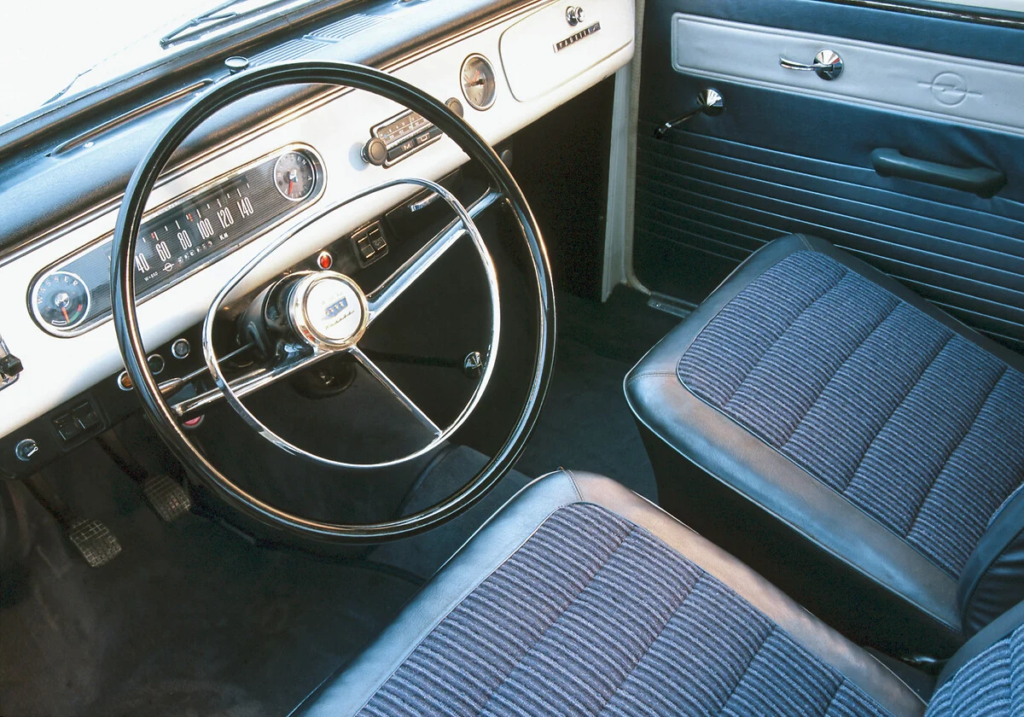
Practical functionality characterized the Kadett’s interior design philosophy. A horizontal speedometer dominated the instrument panel, accompanied by supporting gauges for fuel and temperature. All controls featured logical placement with straightforward operation rather than stylistic flourishes. Front bucket seats provided comfort adequate for daily driving, while the rear bench accommodated three passengers on shorter journeys. The four-speed manual transmission operated through a floor-mounted shifter with typical GM precision of the era. Durable vinyl upholstery covered the seating surfaces, prioritizing longevity over luxury feel. Interior storage included a modest glove box and door pockets for small items. Heating and ventilation systems performed adequately under most conditions, though defrosting required patience on cold mornings. If you’re lucky enough to slide behind the wheel of a preserved Kadett today, you’ll appreciate how its straightforward controls and excellent visibility make it immediately drivable even for those accustomed to modern vehicles – a testament to thoughtful ergonomic design that transcends its era.
17. DKW F102 (Exterior)

Automotive transition marked the DKW F102 as the final model before the brand evolved into Audi. Measuring 169.3 inches on a 100.4-inch wheelbase, this forward-thinking sedan broke from typical compact design with front-wheel-drive and modern styling. The distinctive front featured quad headlights flanking a horizontal grille, creating visual presence beyond its size class. Weighing 1,962 pounds, the F102 derived power from an unusual 1175cc three-cylinder two-stroke engine producing 60 horsepower and 74 lb-ft of torque. This unconventional powerplant delivered a top speed of 87 mph with 0-60 mph acceleration in 17 seconds – respectable performance for its category. The F102’s advanced engineering reflected Auto Union’s technical heritage before the DKW badge gave way to the reborn Audi brand. Next time you admire a modern Audi’s progressive engineering, remember that its DNA traces directly back to this transitional model – the technological bridge between Auto Union’s pre-war innovations and Volkswagen’s reinvention of the brand.
DKW F102 (Interior)
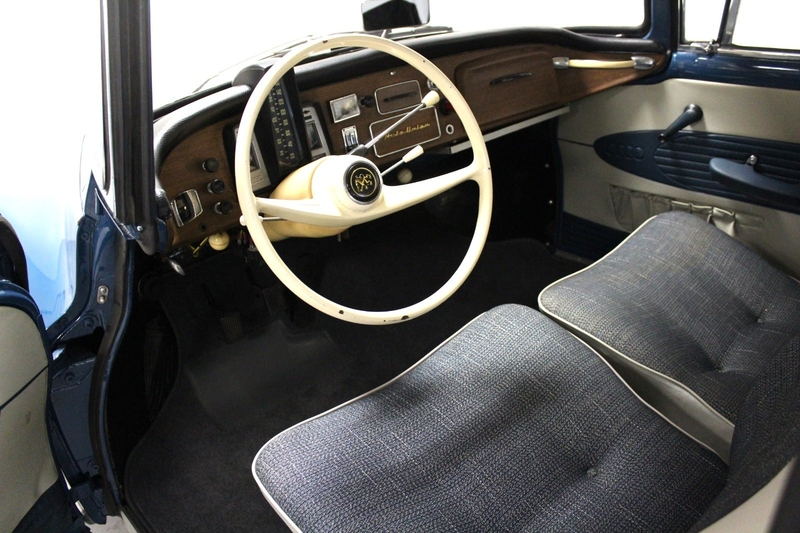
Engineering priorities shaped the F102’s cabin experience with German precision. A driver-focused dashboard arranged round gauges in clear view, featuring white-on-black markings for excellent readability even in changing light conditions. Front bucket seats provided proper support for extended drives, while the rear bench accommodated three passengers with reasonable legroom. The four-speed manual transmission operated through a floor-mounted shifter positioned for comfortable reach. Limited sound insulation meant the distinctive buzz of the two-stroke engine remained ever-present, creating an auditory experience unlike four-stroke competitors. Heating and ventilation systems performed adequately though window defogging required attention in damp conditions. Interior materials emphasized durability over luxury, reflecting the car’s practical German engineering philosophy. You’d instantly recognize the F102’s two-stroke symphony from blocks away – a mechanical soundtrack that divided opinion but certainly ensured this DKW would never be mistaken for anything else on the road.
16. Mercedes-Benz 190c (1961) (Exterior)
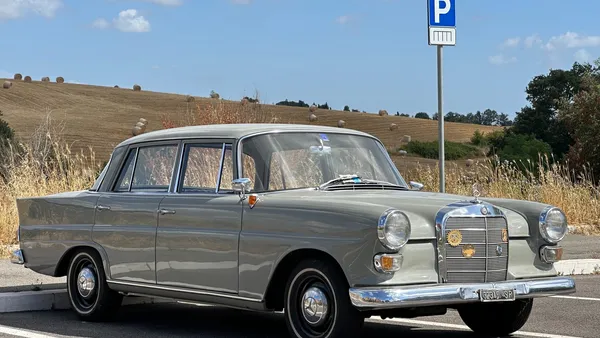
Compact luxury arrived in the Mercedes-Benz 190c, bringing the brand’s engineering excellence to a smaller platform. Substantial dimensions of 180 inches on a 106.3-inch wheelbase provided presence while maintaining manageable proportions. The dignified 2,700-pound sedan featured classic Mercedes design elements including a prominent grille with the three-pointed star, clean body lines, and tasteful chrome accents. Two distinct powertrains offered buyer choice: a 1897cc petrol inline-four producing 80 horsepower and 108 lb-ft of torque, or a 1988cc diesel delivering 55 horsepower and 93 lb-ft of torque. The petrol version achieved a top speed of 93 mph with 0-60 mph acceleration in 16 seconds, while the diesel reached 81 mph and 60 mph in 28 seconds. Introduced in 1961, the 190c established Mercedes’ ability to deliver authentic luxury in a more efficient package. This groundbreaking compact luxury formula established the blueprint for Mercedes’ later C-Class – proving that prestige could be delivered in smaller packages without diluting the brand’s core values.
Mercedes-Benz 190c (Interior)
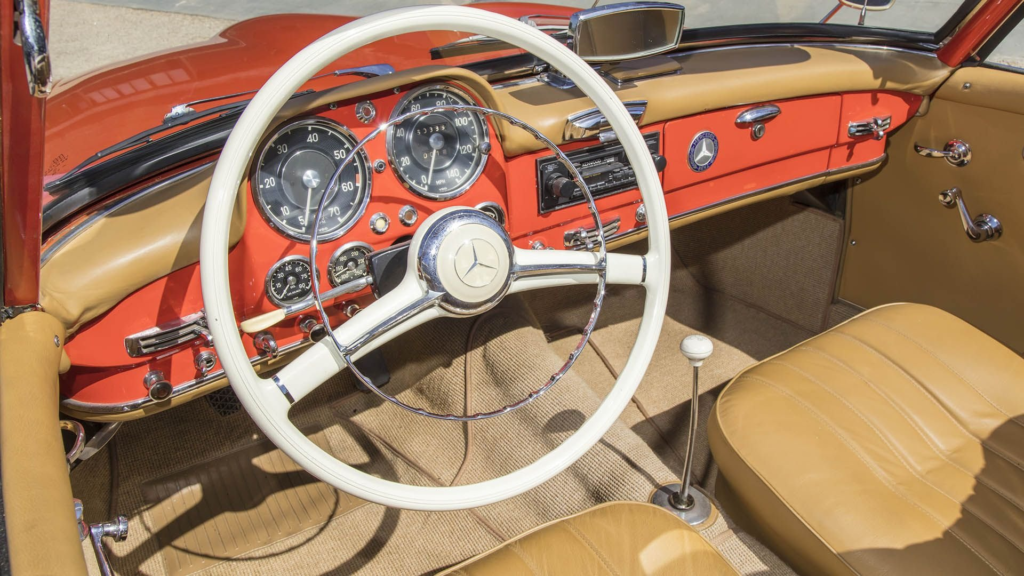
Uncompromised luxury defined the 190c’s interior despite its position as Mercedes’ entry-level offering. The elegantly designed dashboard featured round gauges set in polished bezels, complemented by genuine wood trim across the fascia. High-quality materials appeared throughout, from the wool carpet covering the floor to chrome-plated window cranks and door handles. Front bucket seats offered exceptional comfort with proper support for long-distance travel. The rear bench accommodated three adults with generous legroom that belied the car’s compact classification. The four-speed manual transmission operated through a column-mounted shifter, though an automatic option became available for those preferring two-pedal operation. Interior silence surpassed most competitors with comprehensive sound insulation that hushed road and wind noise. Slide behind the wheel of a 190c today and you’ll be astonished by how modern it feels – the impressive build quality and attention to detail demonstrate why these models command premium prices among collectors who appreciate engineering excellence over mere nostalgia.
15. Fiat 500D (1960) (Exterior)
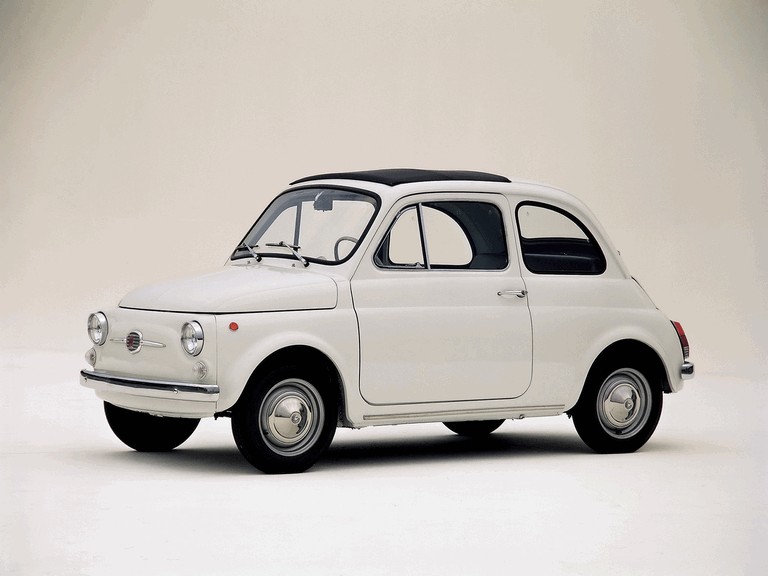
Italian minimalism defined the Fiat 500D with dimensions optimized for narrow European streets. Measuring just 117 inches on a 72.4-inch wheelbase, this automotive icon weighed a mere 1,036 pounds thanks to its efficiently designed body shell. Design elements included a curved, bubble-like profile with “suicide doors” hinged at the rear for entry. Round headlights and minimal chrome trim contributed to the clean, functional aesthetic that became instantly recognizable worldwide. Power came from a rear-mounted, air-cooled 499.5cc two-cylinder engine producing 17 horsepower and 27 lb-ft of torque – modest output that still propelled the diminutive Fiat to a top speed of 59 mph. The 500D represented a 1960 update to the Nuova 500 introduced in 1957, bringing minor refinements while maintaining the original’s charm. Try parking a 500D in any European city center today and you’ll instantly understand its enduring appeal – the tiny footprint that made it perfect for navigating medieval streets remains just as relevant in our congested modern world.
Fiat 500D (Interior)
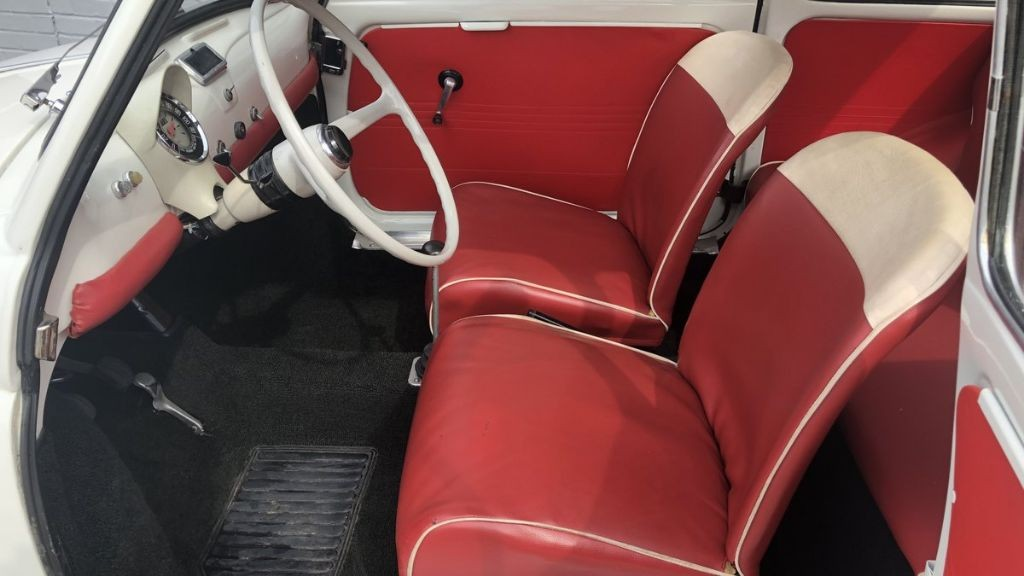
Clever Italian design maximized functionality within the 500D’s tiny footprint. A minimalist dashboard featured just essential instrumentation – a speedometer and fuel gauge – with few supplementary controls beneath. The large, thin-rimmed steering wheel operated with a direct mechanical connection to the front wheels. A front bench seat accommodated two adults in close proximity, while the rear bench offered space better suited for children or additional cargo on folded seatbacks. The four-speed manual transmission operated through a floor-mounted shifter with non-synchronized first gear. Interior surfaces featured painted metal and vinyl upholstery chosen for durability rather than luxury. The rear-mounted engine left a small front storage compartment for light cargo. Heating came from a simple system that directed warm air from the engine compartment, offering modest comfort in cooler weather. When you fold yourself into a 500’s diminutive cabin today, the intimate connection between driver and machine creates an immersive driving experience that makes modern cars feel unnecessarily isolated by comparison – proving that automotive joy often comes in the smallest packages.
14. Lancia Appia 3rd Series (1959-1964) (Exterior)

Engineering refinement characterized the Lancia Appia 3rd Series beyond its compact 155.5-inch length and 99.2-inch wheelbase. This sophisticated Italian sedan featured distinctive styling with a narrow, V-shaped front grille, subtle body contours, and restrained chrome accents emphasizing its clean design. Weighing 1,874 pounds, the Appia housed a unique 1089cc V4 engine producing 48 horsepower and 58 lb-ft of torque. This uncommon configuration delivered a top speed of 80 mph with 0-60 mph acceleration in 26 seconds. The Appia’s pillarless door design eliminated the B-pillar between front and rear doors, creating an open greenhouse when all windows were lowered. Produced from 1959 to 1963, the 3rd Series represented the final evolution of the Appia line, incorporating numerous refinements over earlier versions. The Appia demonstrated how Lancia’s obsession with technical sophistication created vehicles that transcended their market segments – establishing engineering principles that continue to influence automotive design decades after the company’s golden era ended.
Lancia Appia 3rd Series (Interior)
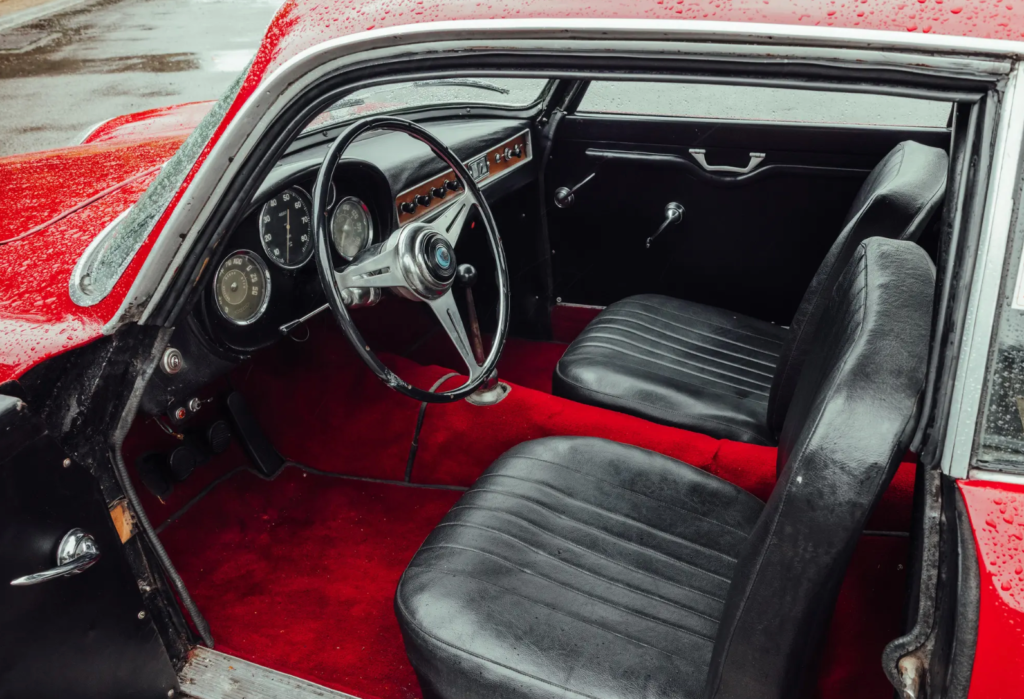
Craftsmanship elevated the Appia’s interior beyond typical compact competitors. The dashboard featured a horizontal speedometer flanked by smaller gauges, all housed in elegant bezels with clear markings. Quality materials appeared throughout, with wood trim accents and high-grade switchgear reinforcing the premium feel. Front bucket seats provided excellent support with upholstery in cloth or optional leather depending on trim level. The rear bench accommodated two adults comfortably despite the car’s compact exterior dimensions. The four-speed manual transmission operated through a floor-mounted shifter with smooth, precise action reflecting Lancia’s mechanical refinement. Interior storage included modest door pockets and a glove compartment sized for essential items. Heating and ventilation systems performed effectively across varied Italian weather conditions. Take a seat in an Appia today and you’ll understand why Lancia once rivaled the finest European marques – the tactile quality of controls and attention to detail demonstrate a level of craftsmanship that mass production has largely surrendered to manufacturing expedience.
13. Alfa Romeo Giulietta Berlina (1961) (Exterior)
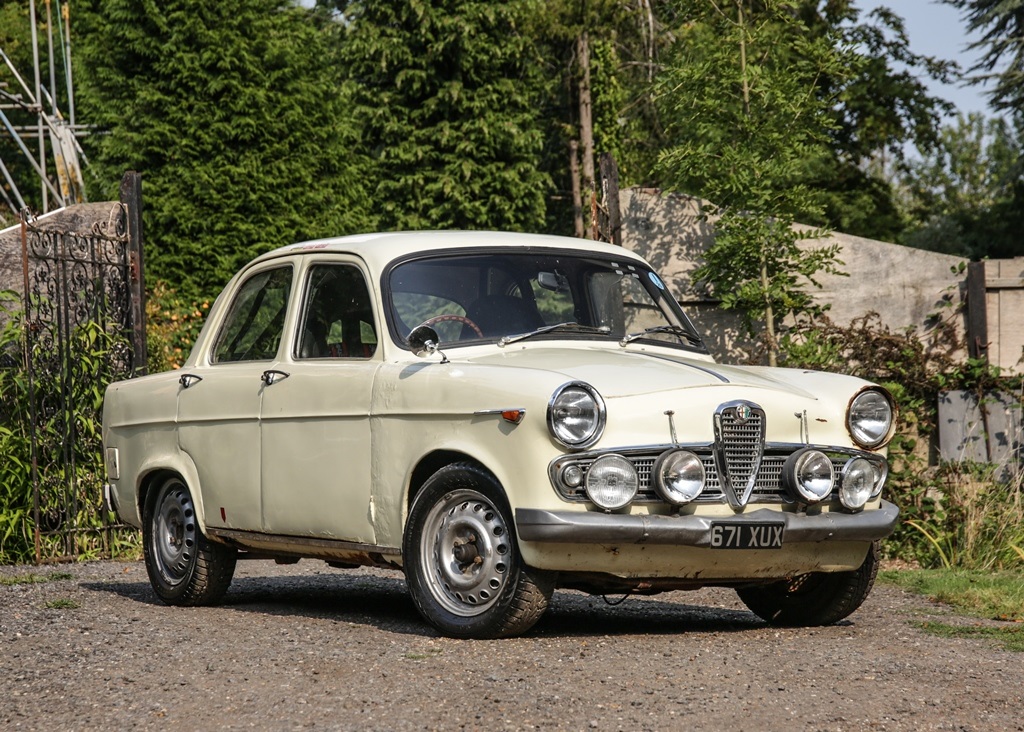
Italian sporting heritage informed the Alfa Romeo Giulietta Berlina’s design while maintaining practical four-door utility. Measuring 157.5 inches on a 93.7-inch wheelbase, this stylish sedan featured distinctive Alfa Romeo design cues including the trademark shield grille and balanced proportions with short overhangs. The 2,072-pound body housed sophisticated engineering including a 1290cc inline-four twin-cam engine producing 74 horsepower and 77 lb-ft of torque – exceptional output for its displacement. This responsive powerplant enabled a 93 mph top speed and brisk 0-60 mph acceleration in 14 seconds. The Giulietta’s lightweight construction and advanced suspension provided handling characteristics that surpassed most competing sedans. In 1961, the model continued refining its existing design while establishing Alfa Romeo’s reputation for combining performance with practicality. Drive a Giulietta today and you’ll discover that its mechanical musicality and engaging handling create an emotional connection that transcends mere transportation – the spiritual ancestor of every modern sport sedan claiming to blend practicality with driving pleasure.
Alfa Romeo Giulietta Berlina (Interior)

Driver engagement defined the Giulietta Berlina’s cabin philosophy without sacrificing four-door practicality. Two large round gauges dominated the instrument panel, displaying speed and engine revs directly in front of the driver with supporting dials for essential systems. The wood-rimmed steering wheel provided direct connection to the road, while the floor-mounted shifter featured the distinctive Alfa pattern emphasizing the car’s sporting character. Front bucket seats delivered lateral support during cornering while remaining comfortable for extended drives. The rear bench accommodated three passengers with adequate space for a compact sedan. Interior materials balanced durability with a touch of Italian flair, avoiding luxury pretension while exceeding basic utility. The Giulietta’s cabin ventilation performed effectively in varied weather conditions, though interior noise levels rose at highway speeds due to limited insulation. Grab the Giulietta’s wood-rimmed wheel today and you’ll feel the connection to Alfa’s racing heritage – the driving position and control layout reveal sporting intentions that prioritized driver involvement over passive comfort decades before “driver-centric” became a marketing buzzword.
12. SEAT 800 (Exterior)

Spanish practicality shaped the SEAT 800 as a four-door extension of the popular SEAT 600. Stretched to 151.6 inches on an 86.6-inch wheelbase, this Spanish compact featured a rounded profile with minimal chrome trim and integrated headlights. Weighing 1,543 pounds, the 800 maintained the rear-engine configuration of its two-door sibling, housing a 767cc inline-four engine producing 29 horsepower and 36 lb-ft of torque. This modest output delivered a top speed of 65 mph – adequate for Spanish roads of the period. The 800’s primary distinction came through its four-door configuration, providing easier access to the rear seats while maintaining compact exterior dimensions. SEAT manufactured approximately 18,000 units between 1964 and 1967, making the model relatively rare compared to the more common two-door 600. While largely forgotten outside Spain, the 800 represents an important chapter in Spanish automotive development – the transformation of licensed foreign technology into practical solutions tailored specifically for local market needs and manufacturing capabilities.
SEAT 800 (Interior)
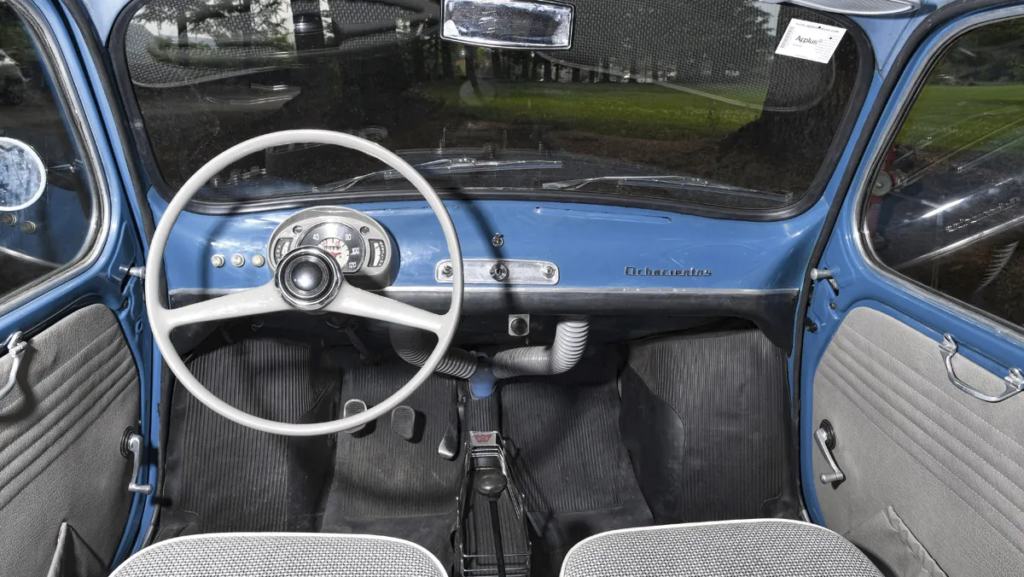
Practical considerations dominated the SEAT 800’s interior design, maximizing passenger access within compact dimensions. A simple dashboard featured a horizontal speedometer with supporting gauges housed in a painted metal panel. Front and rear bench seats accommodated up to five passengers, though interior space remained cozy by modern standards. The four-speed manual transmission operated through a floor-mounted shifter positioned between the front passengers. Basic vinyl upholstery covered the seats while painted metal surfaces dominated door panels and other interior areas. The front trunk offered limited storage space due to spare tire placement and fuel tank location. Heating performance proved adequate for Spain’s predominantly warm climate, though ventilation relied heavily on opening windows. You’d appreciate the 800’s most significant advantage over the 600 during family outings – those rear doors transformed the everyday experience of loading children or elderly passengers, eliminating the awkward seat-folding gymnastics required by two-door designs common in microcars of the era.
11. Saab 96 (Exterior)
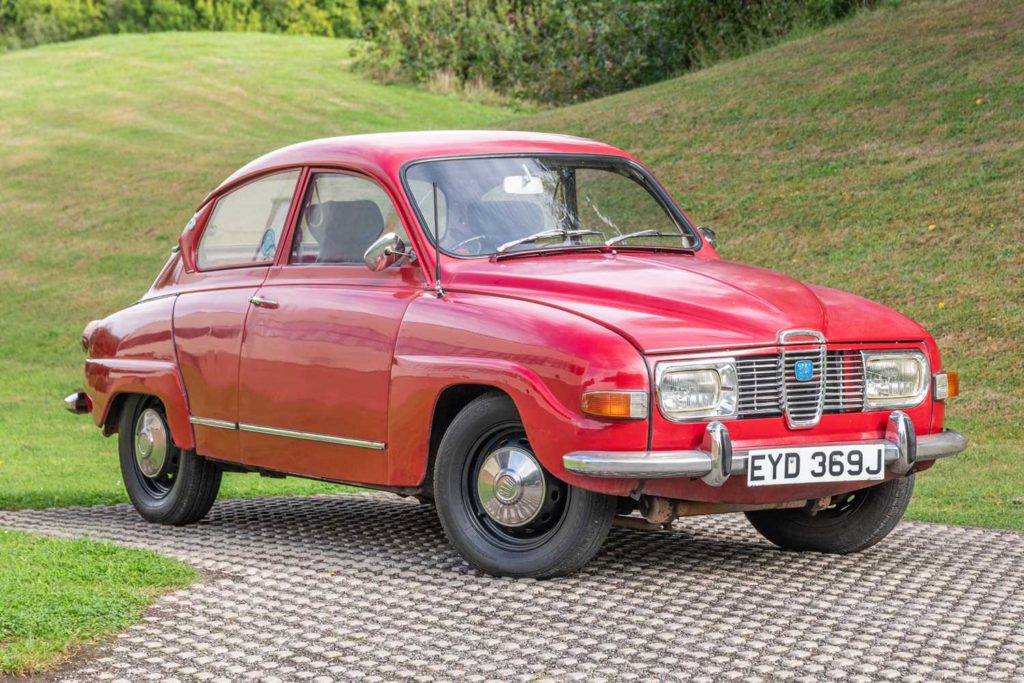
Aviation heritage shaped the Saab 96’s distinctive aerodynamic profile. Stretching 157 inches on a 98-inch wheelbase, this Swedish compact featured aircraft-inspired design elements including a sloping nose, curved windshield, and flowing hood line continuing through the front fenders. Weighing 1,874 pounds, the 96 housed a 748cc three-cylinder two-stroke engine producing 38 horsepower and 54 lb-ft of torque. This modest powerplant achieved a top speed of 75 mph with 0-60 mph acceleration in 23 seconds. The aerodynamic shape contributed to remarkable rally success despite limited power output. Saab’s front-wheel-drive layout provided excellent traction in snowy conditions, perfectly suited to Scandinavian driving requirements. The model remained in production from 1960 to 1980 with various updates, including later V4 engine options that replaced the original two-stroke design. Walk around a preserved 96 today and you’ll see how its unconventional solutions to automotive design problems reflect its aircraft parentage – a philosophy that created cars for people who valued engineering integrity over styling fashions.
Saab 96 (Interior)

Aircraft influence continued inside the 96 with an ergonomic cockpit-like environment. The dashboard housed aircraft-style gauges with logical control placement mimicking aviation design principles. The curved windshield provided exceptional forward visibility while the front bucket seats delivered outstanding comfort and support for long-distance travel. A floor-mounted shifter operated the four-speed manual transmission with column-mounted gear change in early models. The rear bench accommodated two adults with reasonable space despite the car’s compact external dimensions. Thoughtful features included an ignition switch mounted initially on the dashboard and later between the seats – a Saab tradition that continued for decades. The heating system was designed specifically for harsh Scandinavian winters, providing effective warmth and defrosting capability. Spend five minutes in a 96 during a Swedish February and you’d understand why Saab owners develop fierce brand loyalty – the comprehensive heating system and excellent visibility demonstrated how thoroughly the car was engineered for its environment rather than merely styled for showroom appeal.
10. Skoda Octavia (1959) (Exterior)
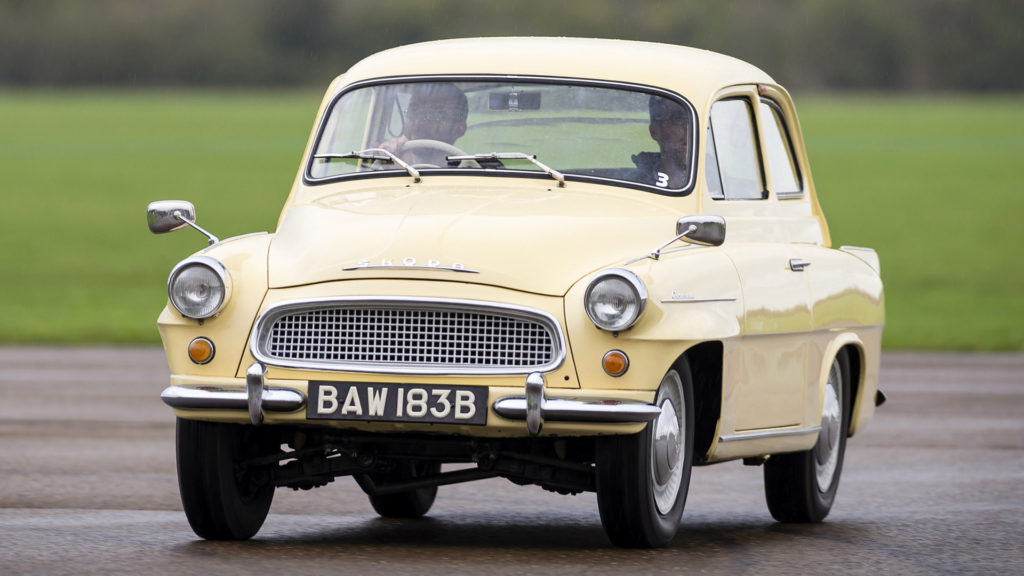
Czech practicality defined the Škoda Octavia through conventional yet effective design. Measuring 157.5 inches on a 94.5-inch wheelbase, this Eastern European sedan featured traditional three-box styling with a rounded front end, prominent grille, and clean body lines. The 2,028-pound body utilized robust construction to handle the rough roads common in its home market. Power came from a 1089cc inline-four engine that, in touring sport form, delivered 50 horsepower and 54 lb-ft of torque. This output enabled an 81 mph top speed and 0-60 mph acceleration in 23 seconds. The Octavia’s conventional front-engine, rear-wheel-drive layout provided predictable handling characteristics while simplifying maintenance. Introduced in 1959, the model demonstrated Škoda’s engineering competence despite operating behind the Iron Curtain. The Octavia’s global rally successes shocked Western competitors who had underestimated Eastern Bloc engineering capabilities – proving that innovation could flourish even in controlled economies when talented engineers were given sufficient resources.
Skoda Octavia (Interior)
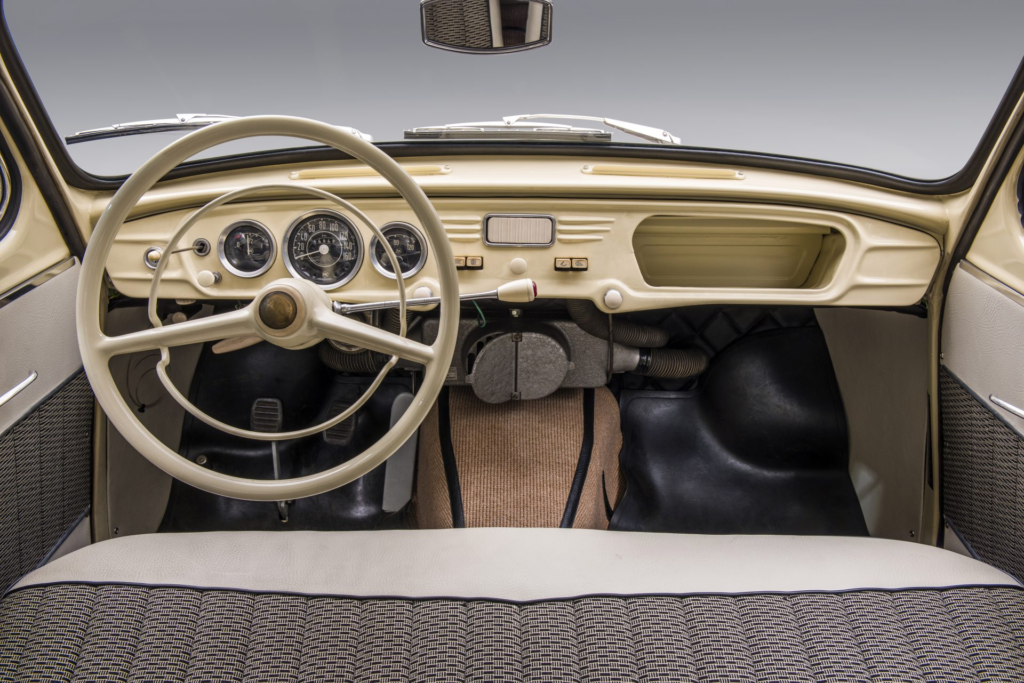
Straightforward functionality characterized the Octavia’s cabin design with Czech practicality evident throughout. A horizontal speedometer dominated the instrument panel, flanked by fuel and temperature gauges with clear markings for easy reading. Front bucket seats provided basic comfort without excessive bolstering, while the rear bench accommodated three passengers on shorter journeys. The four-speed manual transmission operated through a floor-mounted shifter positioned for comfortable reach. Simple vinyl upholstery covered seating surfaces while painted metal dominated door panels and dashboard areas. Heating performance proved adequate for Central European winters, though defrosting required patience in extreme conditions. Storage options included a modest glove compartment and small door pockets. The separate trunk provided secure cargo space with reasonable capacity for the vehicle’s size. If you’d driven an Octavia in the 1960s, you might have been surprised by its fundamental similarity to Western designs – beneath the ideological divisions of the Cold War, the practical requirements of automotive engineering produced remarkably convergent solutions on both sides of the Iron Curtain.
9. ZAZ Zaporozhets 965 (1960) (Exterior)
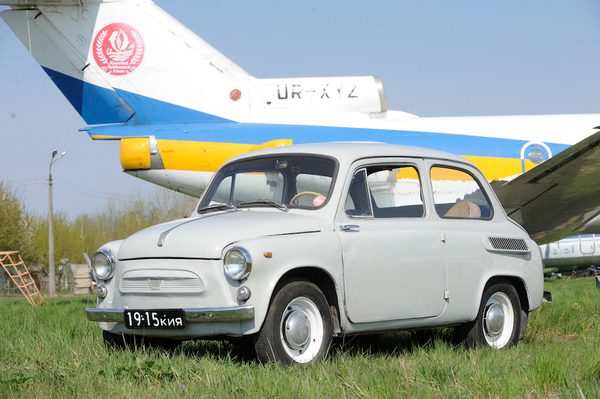
Soviet practicality dominated the ZAZ Zaporozhets 965 with design clearly influenced by the Fiat 600. Measuring 129.9 inches on an 86.6-inch wheelbase, this Ukrainian-built microcar featured rounded body contours, rear-hinged front doors, and a sloping rear housing the engine compartment. Weighing just 1,455 pounds, the 965 employed an air-cooled 746cc V4 engine producing a modest 23 horsepower. This unusual V-configuration engine placement behind the rear axle created distinctive weight distribution affecting handling characteristics. Basic construction kept manufacturing costs low, making automobile ownership possible for ordinary Soviet citizens when personal vehicles remained scarce luxuries. Introduced in 1960, the 965 represented the Soviet Union’s first genuine people’s car program. Unlike Western vehicles designed for rapid obsolescence and styling changes, the 965’s decade-long production run without significant updates reflected the Soviet system’s emphasis on standardization and utility over consumer marketing – creating vehicles that prioritized serviceability over style.
ZAZ Zaporozhets 965 (Interior)
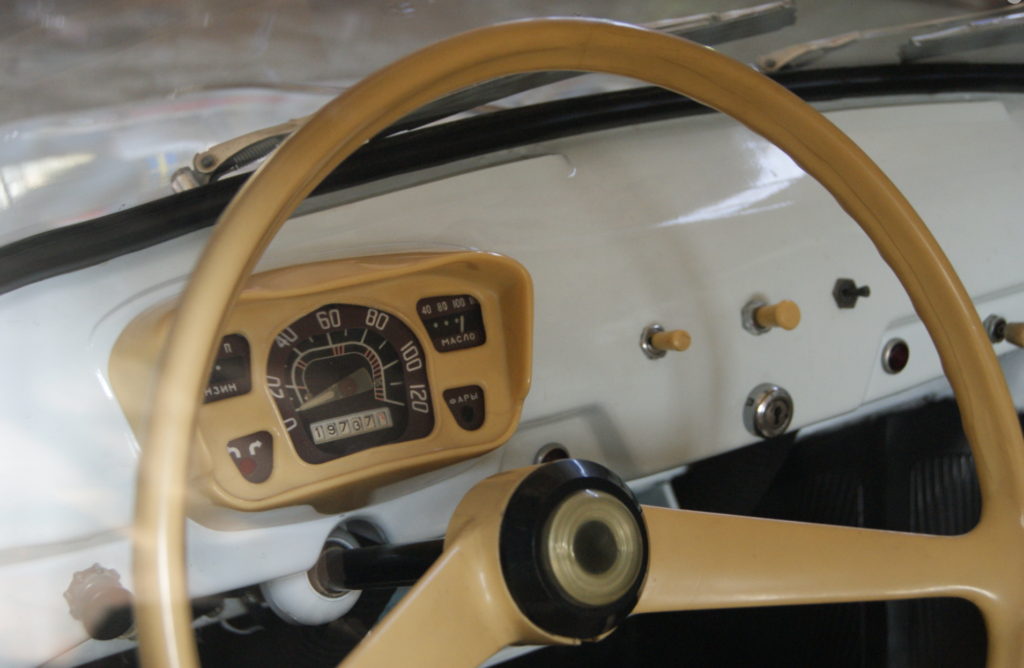
Extreme simplicity characterized the 965’s interior with focus solely on basic transportation needs. The minimalist dashboard featured essential instrumentation limited primarily to a speedometer with few supporting gauges or warning lights. Simple switches controlled headlights and wipers with minimal additional functions. Front bucket seats provided basic support while the rear bench accommodated two passengers in tight quarters. The four-speed manual transmission operated through a floor-mounted shifter with basic mechanical linkage to the rear-mounted gearbox. Thin padding covered seating surfaces while painted metal dominated all other interior surfaces with virtually no sound insulation. Early models lacked even basic amenities like an effective heating system, which proved problematic in Soviet winter conditions. When you compare the 965’s spartan interior to contemporary Western compacts, you’ll understand how dramatically different automotive development paths could be under planned versus market economies – the absence of competitive pressure or consumer choice created vehicles designed to meet minimum transportation requirements rather than attract buyers in a competitive marketplace.
8. Moskvich 407 (Exterior)
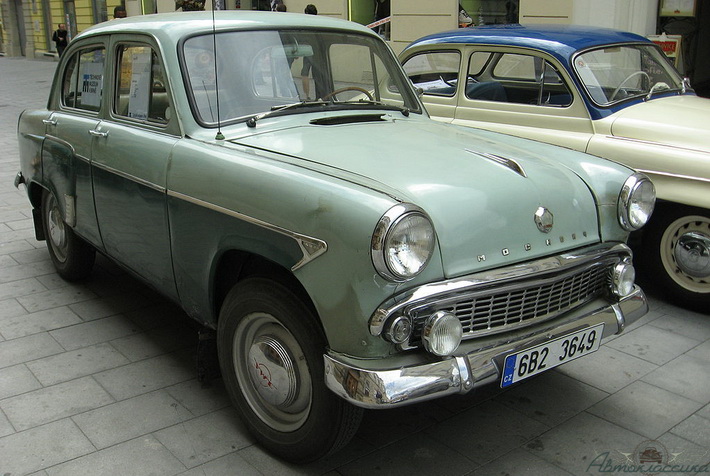
Export ambitions shaped the Moskvich 407 as a showcase for Soviet automotive capability. Spanning 157.5 inches on a 94.5-inch wheelbase, this sedan featured conservative styling with a rounded front end, prominent grille, and conventional three-box proportions. Weighing 2,161 pounds, the 407 employed a 1358cc inline-four engine producing 45 horsepower and 64 lb-ft of torque. This output delivered a top speed of 71 mph with 0-60 mph acceleration taking 35 seconds. Chrome trim adorned the grille, bumpers, and body sides, adding visual interest to the otherwise straightforward design. Manufactured from 1958 to 1963, the 407 found markets both within the Soviet bloc and in selected Western countries where it competed on price rather than sophistication. Drive a Moskvich today and you’ll experience automotive history from a rarely-considered perspective – the determined effort of Soviet industry to create internationally competitive products despite technological isolation and centralized economic planning that prioritized production quantity over quality refinement.
Moskvich 407 (Interior)
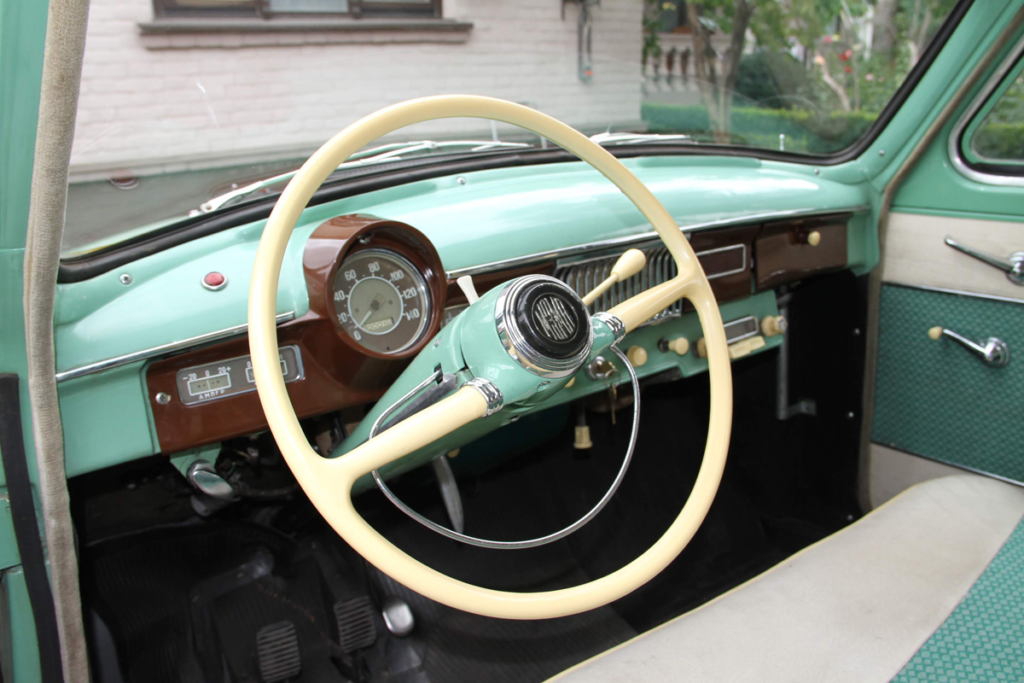
Functional adequacy defined the 407’s interior with modest concessions to driver and passenger comfort. The dashboard featured a horizontal speedometer with supporting gauges for fuel and temperature housed in a painted metal panel with minimal decoration. Front and rear bench seats accommodated up to five passengers with sufficient room but limited padding for comfort on longer journeys. The four-speed manual transmission operated through a column-mounted shifter, freeing floor space between the front passengers. Vinyl upholstery covered seating surfaces while painted metal dominated door panels and dashboard areas. The separate trunk provided secure cargo space with good capacity relative to the vehicle’s external dimensions. Heating performance varied widely depending on maintenance condition, with Soviet climate extremes challenging the system’s capabilities. You might smile at the 407’s interior simplicity by modern standards, but for many Soviet families, this modest sedan represented a life-changing improvement in personal mobility – transforming weekend recreation possibilities and expanding employment options beyond the limitations of public transportation schedules.
7. Rambler American (1961) (Exterior)
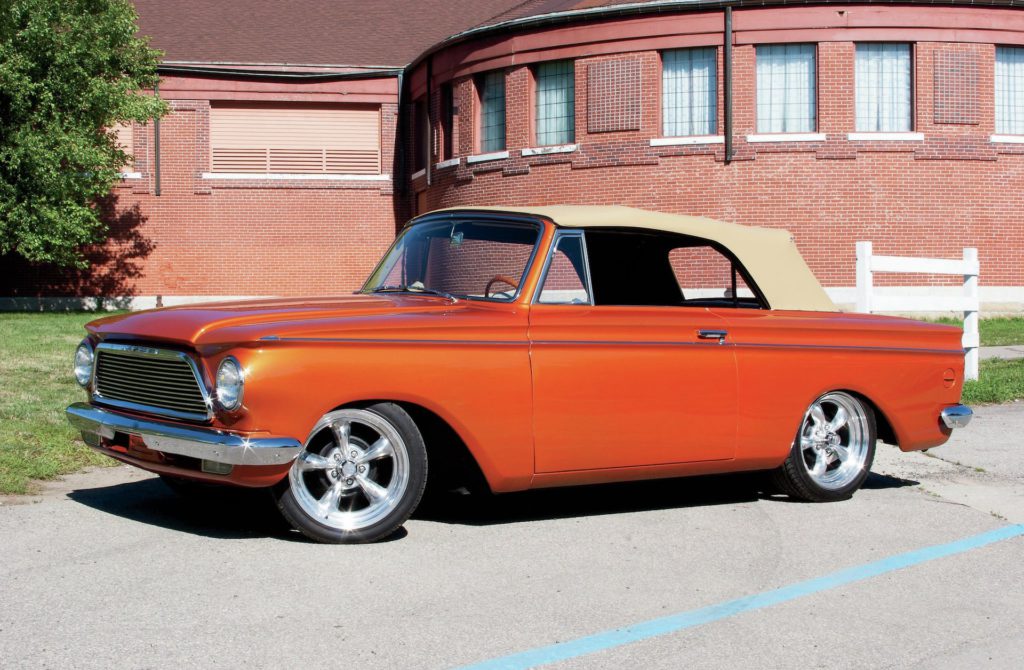
The 1961 American revitalized Rambler’s compact strategy with practical dimensions that suburban drivers craved. Its 100-inch wheelbase and 178-inch length made navigating crowded shopping centers a breeze while the light 2,400-pound body responded eagerly to steering inputs. You’d notice how the clean exterior avoided the chrome excesses that weighed down competitors, making the American look sensible rather than showy. Unlike most economy cars, Rambler maintained adequate passenger space despite trimming exterior fat. When your neighbors pulled up in their massive Cadillacs and Lincolns, your American made a different statement—here was a car that solved real transportation problems without the fuel-gulping excess that Detroit typically pushed on middle-class buyers.
Rambler American (1961) (Interior)

Climb inside the American and you’d discover straightforward functionality that never wasted space or your attention. The cabin seated five without the claustrophobia that plagued many compacts—a welcome relief on family road trips. Front and rear benches traded plushness for support that held up during all-day drives. Simple, legible gauges told you what you needed to know without unnecessary complications, while durable vinyl seats shrugged off spills and dirt with minimal maintenance. The glove box and door pockets swallowed maps and travel essentials without fuss. While Detroit’s luxury models dazzled with gadgets that frequently broke, the American’s honest interior represented a counter-movement that prioritized function over flash—an approach that would eventually force the entire industry to reconsider what American car buyers truly valued.
6. Subaru 360 (Exterior)

Aerodynamic efficiency shaped the Subaru 360, earning it the affectionate “ladybug” nickname that captured both its appearance and the public’s embrace. Measuring just 117 inches on a 71-inch wheelbase, this microcar featured a distinctive rounded body profile, large greenhouse, and “suicide doors” hinged at the rear. Weighing an incredibly light 926 pounds thanks to fiberglass reinforced plastic body panels, the 360 employed a rear-mounted 356cc two-stroke engine producing 25 horsepower and 26 lb-ft of torque. This surprisingly efficient powerplant achieved a top speed of 53 mph despite its tiny displacement. Subaru’s aircraft heritage influenced the monocoque construction and attention to aerodynamics, creating a coefficient of drag lower than many larger contemporary vehicles. The 360’s pioneering use of lightweight materials and aerodynamic principles anticipated efficiency strategies that would become automotive industry standards decades later – establishing Subaru’s engineering credentials long before their symmetrical all-wheel-drive systems became their signature technology.
Subaru 360 (Interior)
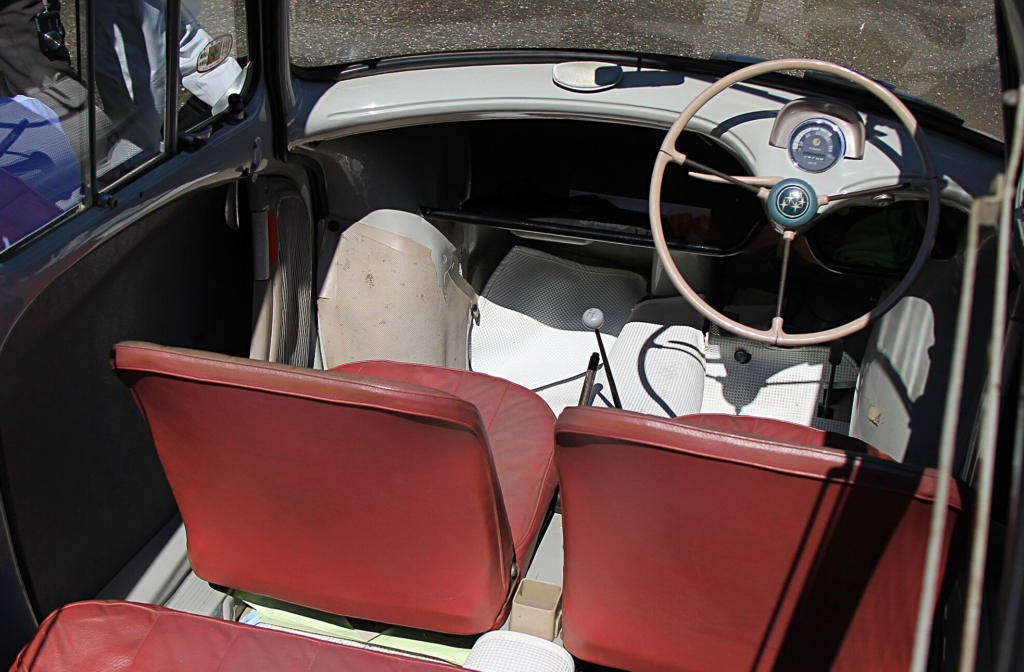
Clever packaging maximized the 360’s interior functionality despite its minimal external footprint. The dashboard featured basic instrumentation focused on essential information rather than comprehensive data. Front bucket seats sat close together but provided adequate comfort for urban journeys, while the rear bench accommodated two passengers for shorter trips. The four-speed manual transmission operated through a floor-mounted shifter positioned for easy reach. Basic materials covered seating surfaces and interior panels, with painted metal dominating most surfaces. Despite its tiny dimensions, the 360 provided surprising headroom thanks to its tall bubble-like greenhouse design. The front compartment offered minimal storage space, supplemented by areas behind the rear seat. Heating came from a simple system that directed warm air from the engine compartment, providing modest winter comfort. Try squeezing your modern expectations into a 360’s cabin and you’ll gain newfound appreciation for how radically our definition of “necessary space” has expanded – what once transported families now seems barely adequate for a single occupant, revealing how thoroughly prosperity has transformed our automotive expectations.
5. Mazda R360/Carol 600 (1963) (Exterior)
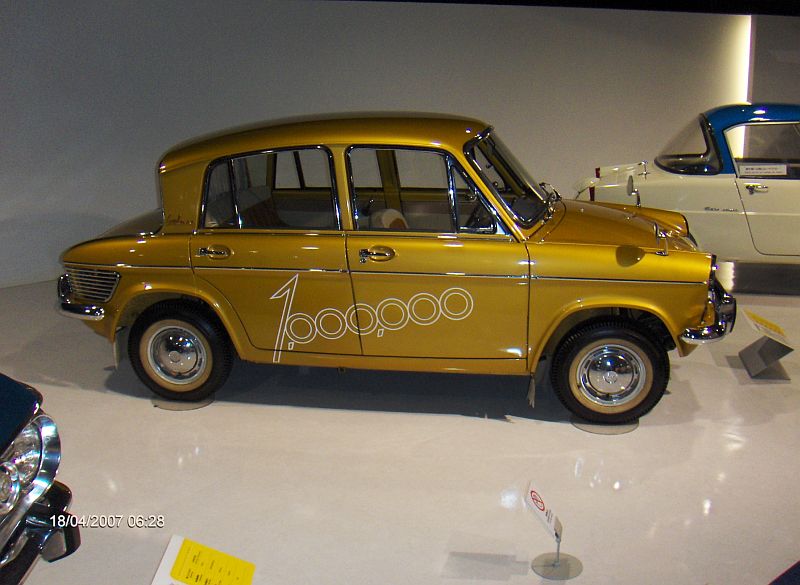
Japanese kei car evolution progressed through Mazda’s early passenger models. The R360 measured just 117 inches on a 71-inch wheelbase with a distinctive rounded profile featuring prominent headlights and unique rear window design. Weighing an extraordinarily light 838 pounds, this microcar utilized a 356cc V-twin four-stroke engine producing 16 horsepower and 16 lb-ft of torque. The later Carol 600 expanded this concept with a slightly larger 125-inch body and more powerful 586cc four-cylinder water-cooled engine generating 28 horsepower, enabling a top speed of 60 mph. Both models showcased Mazda’s engineering creativity as the company established its passenger car presence. The R360 debuted in 1960 as Mazda’s first passenger car, followed by the Carol in 1962 targeting a slightly higher market segment. These humble beginnings established engineering foundations that would later support Mazda’s revolutionary rotary engine development – proving that innovation often emerges from companies willing to challenge conventional thinking regardless of their size or market position.
Mazda R360/Carol 600 (Interior)

Space efficiency dominated Mazda’s microcar interior design philosophy. Both models featured minimalist dashboards with essential instrumentation focused on critical information rather than comprehensive data. The R360 coupe accommodated two occupants in its front bucket seats, while the Carol 600 added a rear bench for occasional passengers. The four-speed manual transmission operated through a floor-mounted shifter with direct mechanical linkage. Simple materials covered interior surfaces with durability taking precedence over luxury or comfort considerations. The R360 offered front-hinged doors unlike some competitors’ rear-hinged designs, providing easier entry and exit in tight parking situations. Both models maximized interior space through efficient packaging, offering reasonable accommodation despite severe external size limitations. If you’d been a Japanese consumer transitioning from motorcycle to automobile ownership in the early 1960s, these Mazda models would have represented a quantum leap in comfort and practicality – the beginning of an automotive relationship that transformed Japan from a nation of riders to a nation of drivers in just one generation.
4. Toyota Publica (1961) (Exterior)
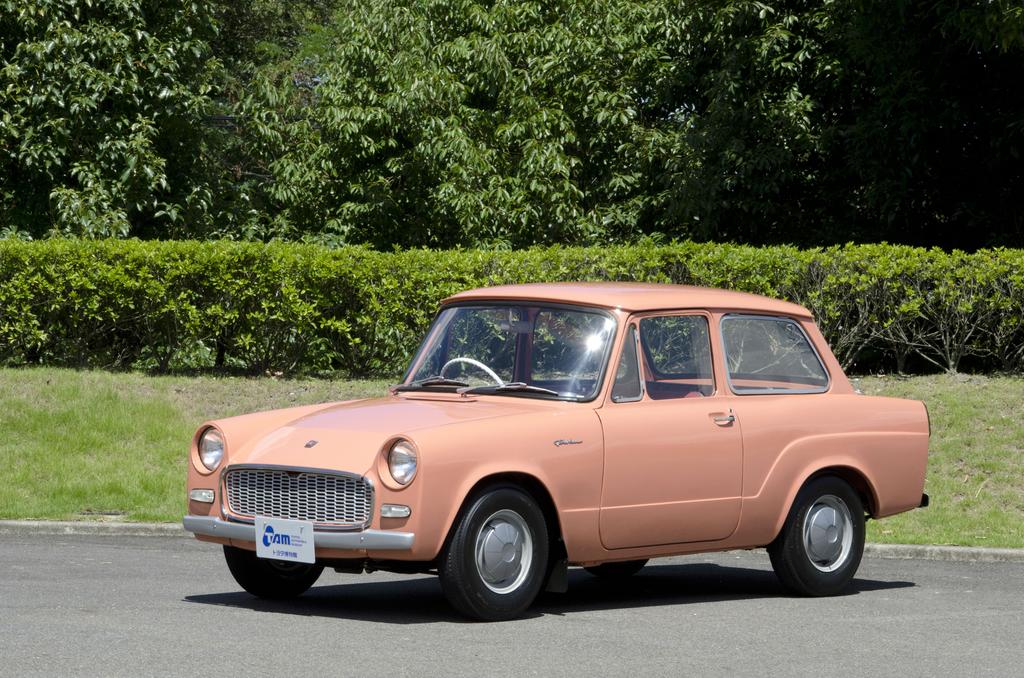
Engineering reliability defined the Toyota Publica from its initial design concept. Measuring 140 inches on an 86.6-inch wheelbase, this Japanese compact featured clean, unadorned styling with a conventional three-box design and minimal chrome trim. Weighing 1,279 pounds, the Publica employed an air-cooled 697cc two-cylinder boxer engine producing 28 horsepower – modest output prioritizing economy over performance. The model’s simple, robust mechanical design emphasized reliability and easy maintenance, establishing Toyota’s reputation for dependability even in their most affordable offerings. Introduced in 1961, the Publica initially sold below expectations before gaining popularity as Toyota’s brand reputation strengthened. The Publica’s boxer engine configuration might have seemed an engineering curiosity at the time, but it established Toyota’s willingness to explore unconventional solutions – a technical flexibility that would later help the company adapt to changing market requirements more effectively than many competitors wedded to traditional approaches.
Toyota Publica (Interior)
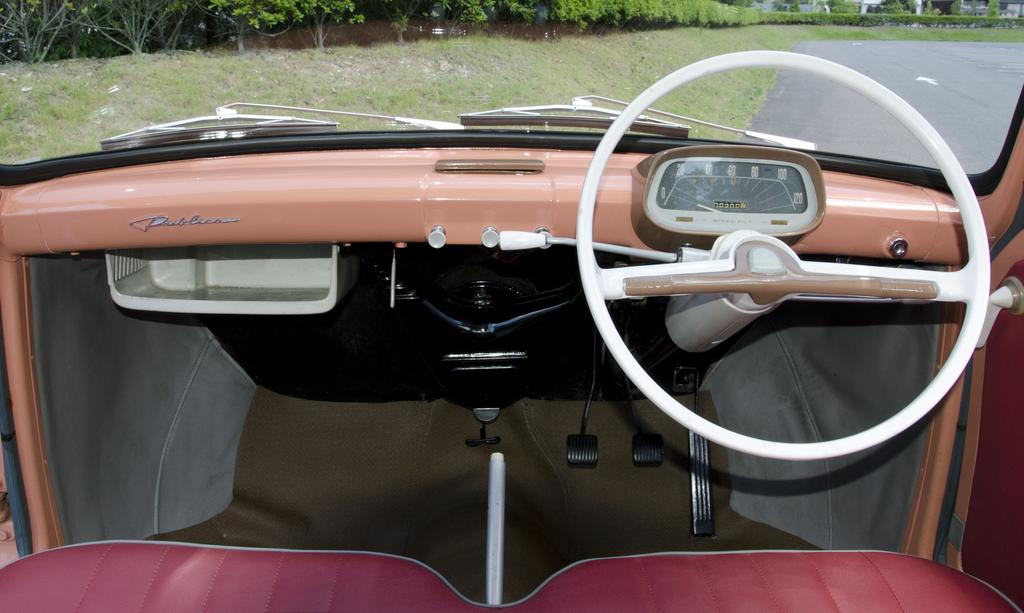
Practical functionality characterized the Publica’s interior with straightforward design and controls. The dashboard featured a simple horizontal speedometer with minimal supporting gauges. Front bucket seats provided basic comfort while the rear bench accommodated two adults in adequate space for a car of this size. The four-speed manual transmission operated through a floor-mounted shifter with typical Toyota precision. Durable materials covered the seats and interior surfaces, emphasizing longevity over luxury or style considerations. The separate trunk provided practical cargo space despite the car’s compact external dimensions. Heating and ventilation systems performed adequately across Japan’s varied climate conditions. Looking at a Publica today, you might struggle to find any design flourishes or distinctive features – exactly as Toyota intended. While competitors chased styling trends or technical novelty, Toyota focused on perfecting fundamental reliability that would eventually make them the world’s largest automaker – proving that doing the basics exceptionally well can ultimately be more revolutionary than pursuing obvious innovation.
3. Daihatsu Compagno (Exterior)

Italian design influence elevated the Daihatsu Compagno beyond typical Japanese styling of the era. Spanning 151.6 inches on an 86.6-inch wheelbase, this compact offered multiple body styles including coupe, sedan, and convertible variants to suit different buyer needs. Weighing 1,653 pounds, the Compagno featured clean lines, a distinctive front grille, and balanced proportions unusual for Japanese cars of this period. Power came from a 797cc inline-four engine producing 41 horsepower and 43 lb-ft of torque, enabling a top speed of 68 mph with 0-60 mph acceleration in 25 seconds. The Compagno represented Daihatsu’s effort to create more sophisticated automobiles beyond their microcar origins. The international styling collaboration that shaped the Compagno anticipated the global design partnerships that would later become common throughout the automotive industry – an early example of Japanese manufacturers looking beyond their borders for design expertise while maintaining their engineering independence. Also if you’re a lover of detective TV shows, then these cars might be fascinating to you.
Daihatsu Compagno (Interior)
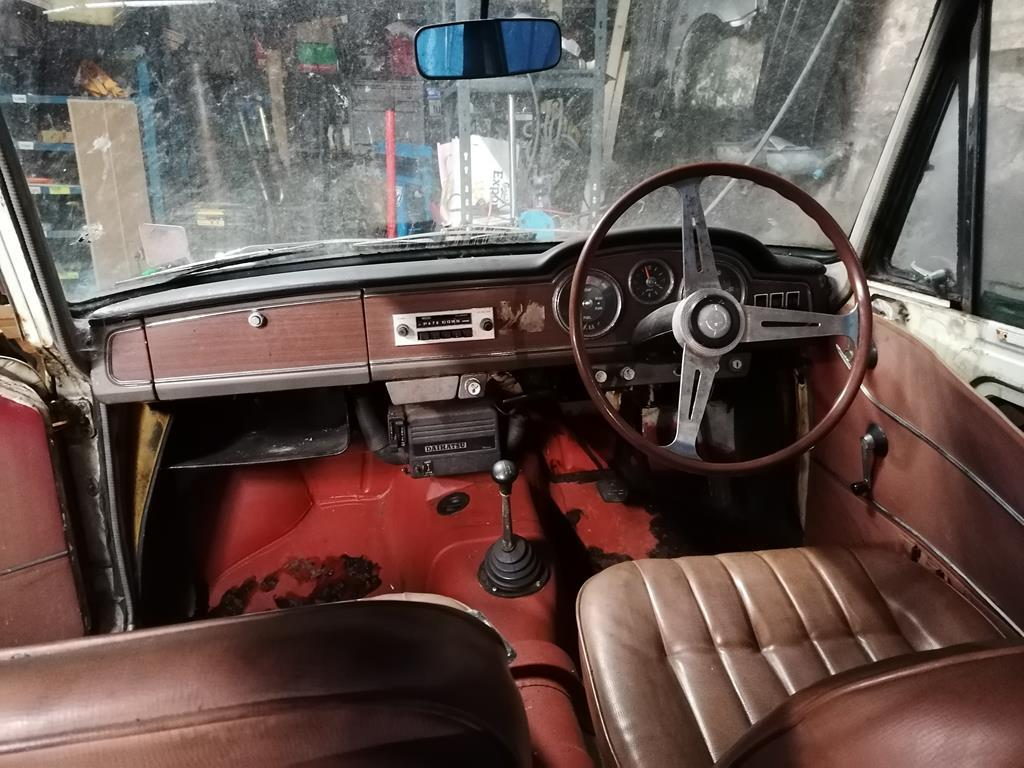
Thoughtful design elevated the Compagno’s cabin beyond utilitarian Japanese compacts of the period. The dashboard arranged instruments in a clean layout with a horizontal speedometer and supporting gauges for engine functions. Front bucket seats provided good support for the era, while the rear bench accommodated two adults without excessive crowding. The four-speed manual transmission operated through a floor-mounted shifter with clear gear positions. Vinyl upholstery covered seating surfaces while door panels and the dashboard featured more design consideration than many economy competitors. Heating and ventilation systems performed adequately across Japan’s varied climate conditions. Step into a preserved Compagno today and you’d immediately notice how its interior ambience bridges Japanese engineering pragmatism with European design influence – the visual harmony and attention to detail represented a significant leap forward for Japanese manufacturers learning to balance functionality with aesthetic appeal in their pursuit of international market acceptance.
2. Datsun 310 Bluebird (1960) (Exterior)
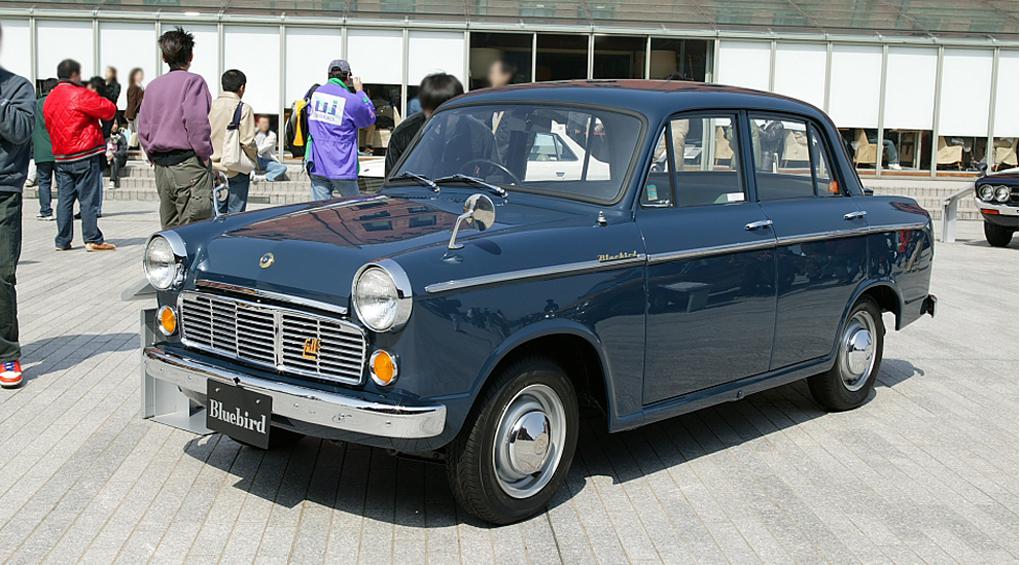
Export market ambitions shaped the Datsun 310 Bluebird with international styling influences. Measuring 148 inches on an 88.6-inch wheelbase, this Japanese sedan featured clean lines with modest chrome trim, a distinctive front grille, and well-proportioned body design. Weighing 1,764 pounds, the Bluebird housed a 1189cc inline-four engine producing 60 horsepower and 70 lb-ft of torque in U.S. specification. This output delivered a top speed of 75 mph with 0-60 mph acceleration in 20 seconds – respectable performance for its class. The model continued production for 1960 after its 1959 introduction, with ongoing refinements improving reliability and performance. When examining the Bluebird’s conservative yet confident styling, you’re witnessing the blueprint for Nissan’s international expansion strategy – creating vehicles that adapted familiar Western design languages while gradually introducing distinctive Japanese engineering approaches that would eventually redefine global automotive standards for reliability and efficiency.
Datsun 310 Bluebird (Interior)
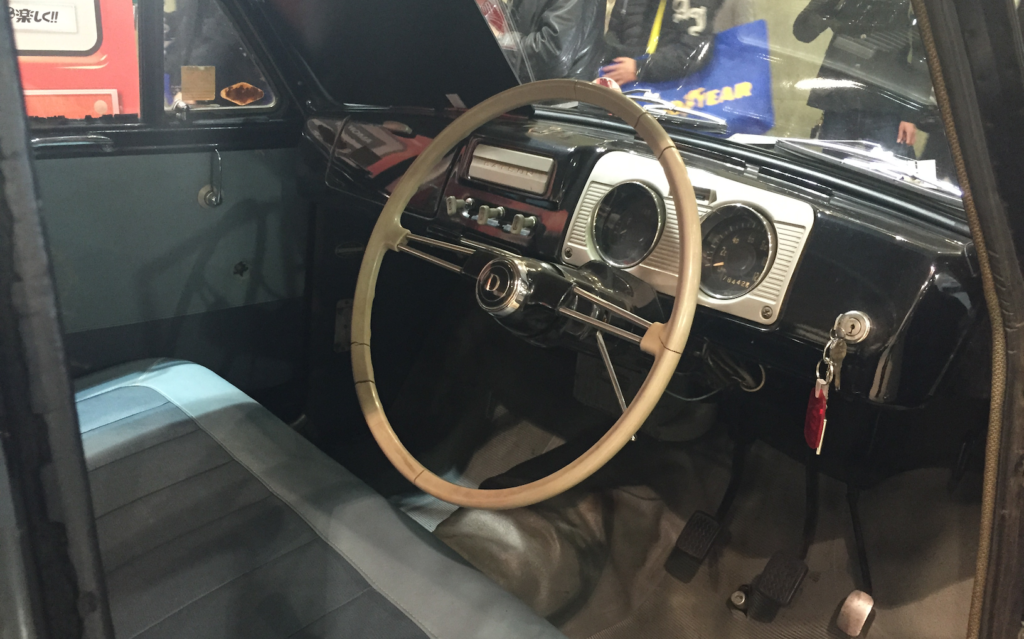
Japanese attention to detail appeared throughout the Bluebird’s functional yet comfortable cabin. The dashboard arranged gauges in a logical layout with a prominent speedometer and supporting instruments for essential vehicle functions. Front bucket seats provided good support for longer drives, while the rear bench accommodated three passengers in reasonable comfort for the vehicle’s size class. The four-speed manual transmission operated through a floor-mounted shifter with direct mechanical action. Durable vinyl upholstery covered the seats while door panels and dashboard areas featured thoughtful design with some soft-touch surfaces unusual in economy cars of this period. Heating and ventilation systems performed adequately across varied climate conditions. If you’d been among the first American buyers transitioning from domestic compacts to this unfamiliar Japanese alternative, the Bluebird’s interior quality would have delivered a surprising revelation – that meticulous assembly precision and material consistency could exist at price points where domestic manufacturers often cut corners, foreshadowing the quality revolution that would transform the global automotive landscape in subsequent decades.
1. Isuzu Bellel (1963) (Exterior)
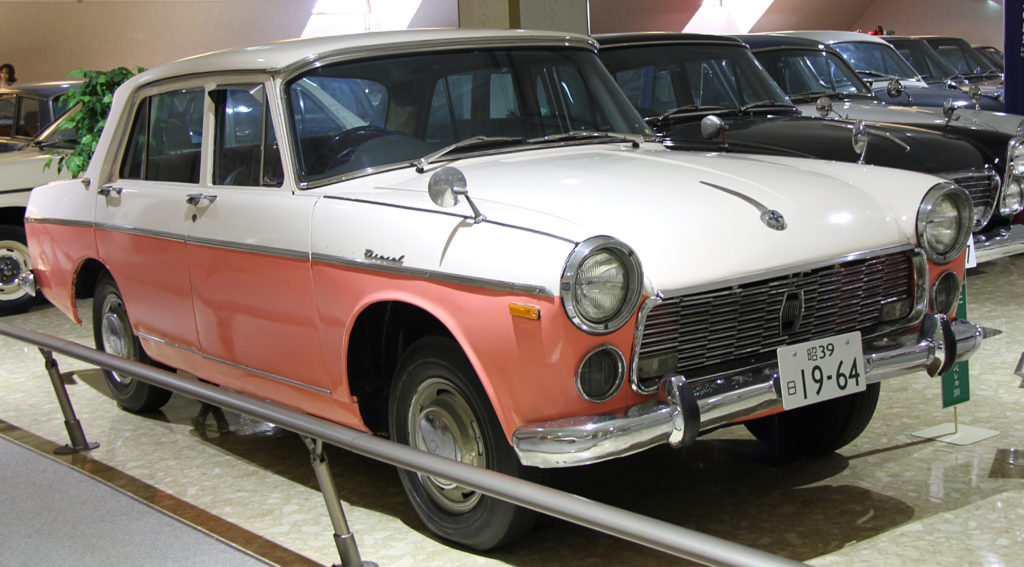
Commercial vehicle heritage informed the Isuzu Bellel’s substantial presence within the compact segment. Measuring 175.2 inches on a 104.3-inch wheelbase, this near-midsize sedan featured conservative styling with a horizontal grille, quad headlights on deluxe models, and clean body lines. Weighing 2,646 pounds, the Bellel offered unconventional powertrain options for its class: a 1491cc gasoline inline-four producing 68 horsepower and 84 lb-ft of torque, or a 1991cc diesel – rare in passenger cars of this size category. The gasoline engine delivered an 81 mph top speed with 0-60 mph acceleration in 20 seconds. Introduced in 1961 with 1963 bringing further refinements, the Bellel represented Isuzu’s early effort to transfer their commercial vehicle engineering expertise to the passenger car market. The Bellel’s diesel option was particularly visionary, anticipating by decades the eventual mainstream acceptance of diesel power in passenger vehicles – demonstrating how Isuzu’s commercial vehicle expertise allowed them to introduce advanced technologies before market demand had fully materialized.
Isuzu Bellel (Interior)
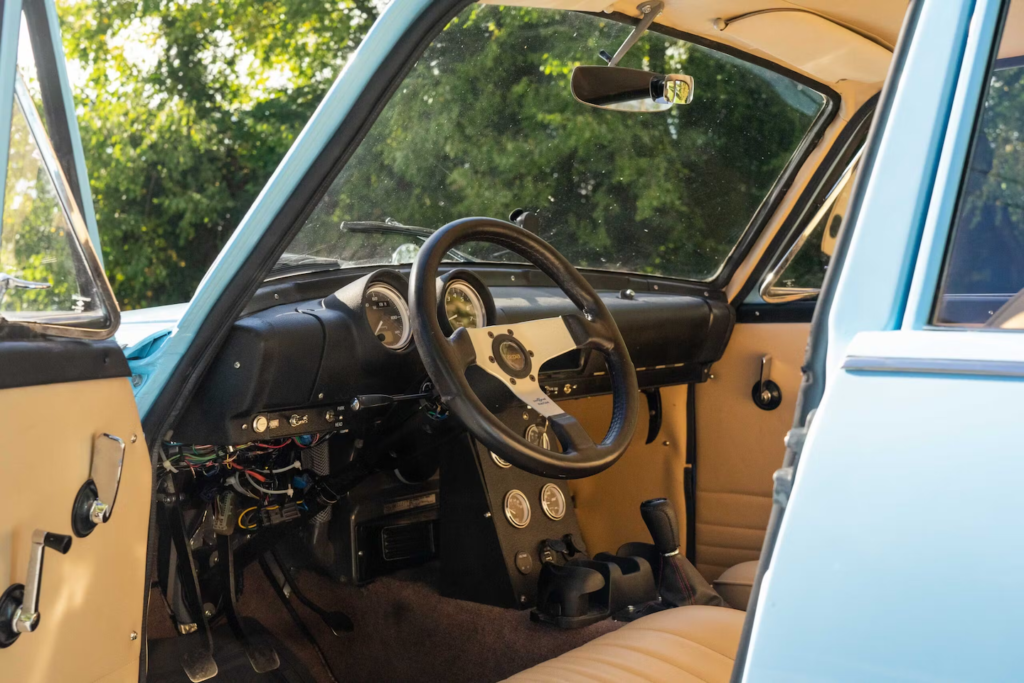
Practical spaciousness defined the Bellel’s cabin, offering near-midsize comfort in a compact package. The dashboard featured a clean, horizontal design with clear instrumentation including a prominent speedometer and supporting gauges for engine functions. Front bucket seats with a center armrest provided comfortable accommodation for longer journeys, while the rear bench offered generous space for three adults – a key selling point against smaller compact competitors. The four-speed manual transmission operated through a column-mounted shifter in most configurations, freeing floor space for a front bench seat option. Durable materials covered all seating surfaces with focus on longevity rather than luxury or style considerations. Heating and ventilation systems performed adequately in varied climate conditions. You’d appreciate the Bellel’s space utilization immediately upon entering – its interior dimensions somehow extracted more usable room from its footprint than seemed geometrically possible, reflecting Isuzu’s expertise in commercial vehicle packaging where maximizing functional space within regulated dimensional limits was a core design principle long before “space efficiency” became a passenger car marketing buzzword.









